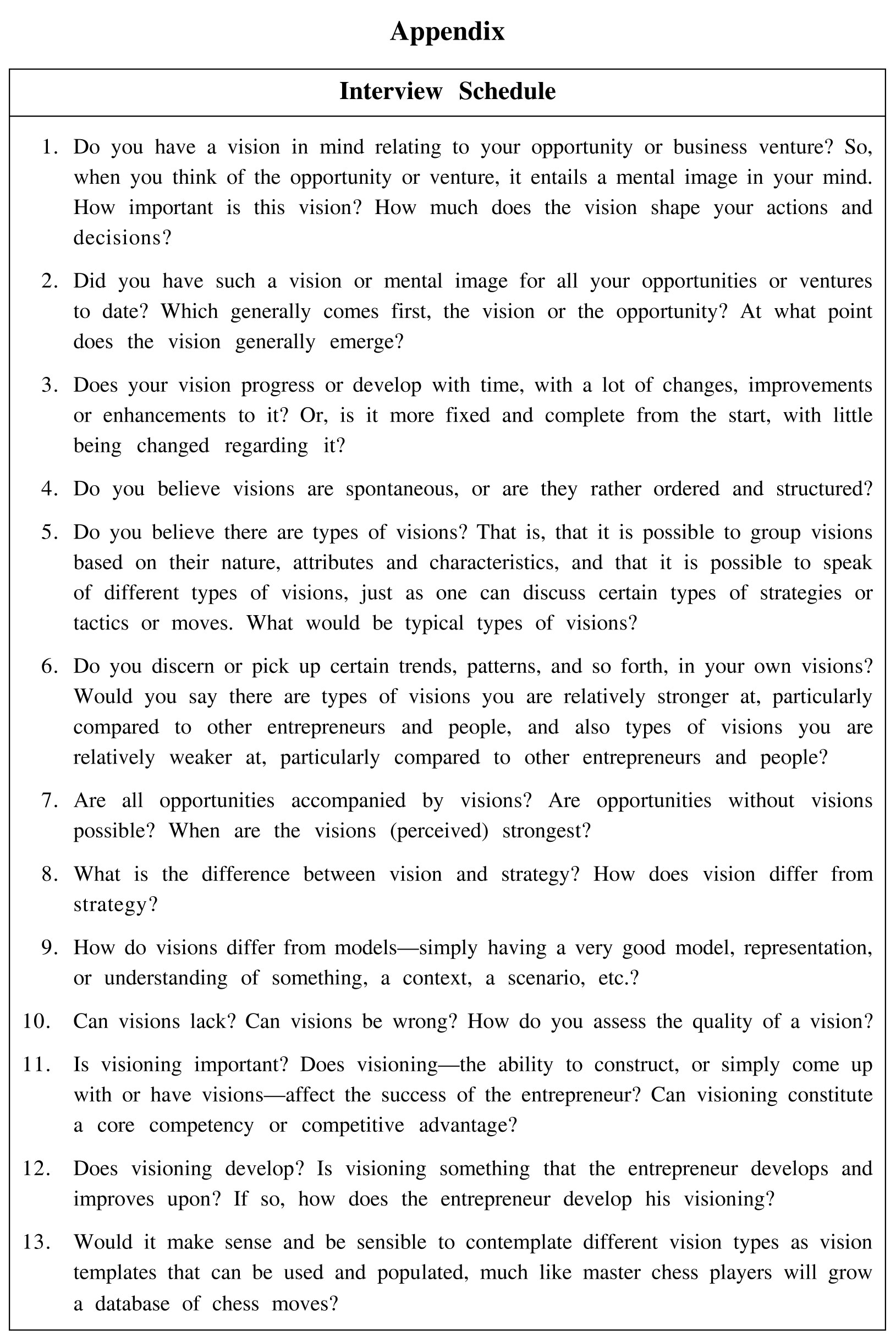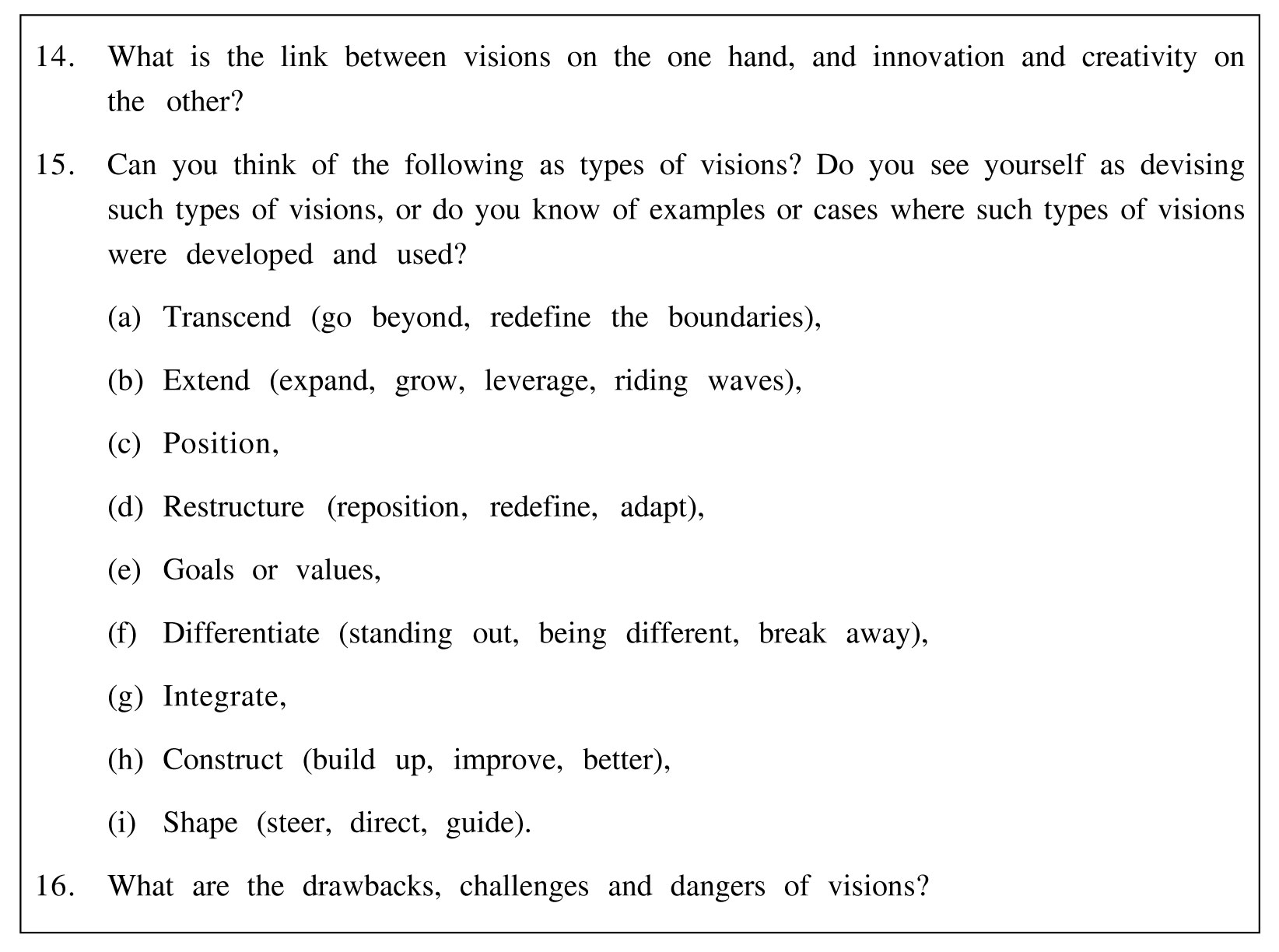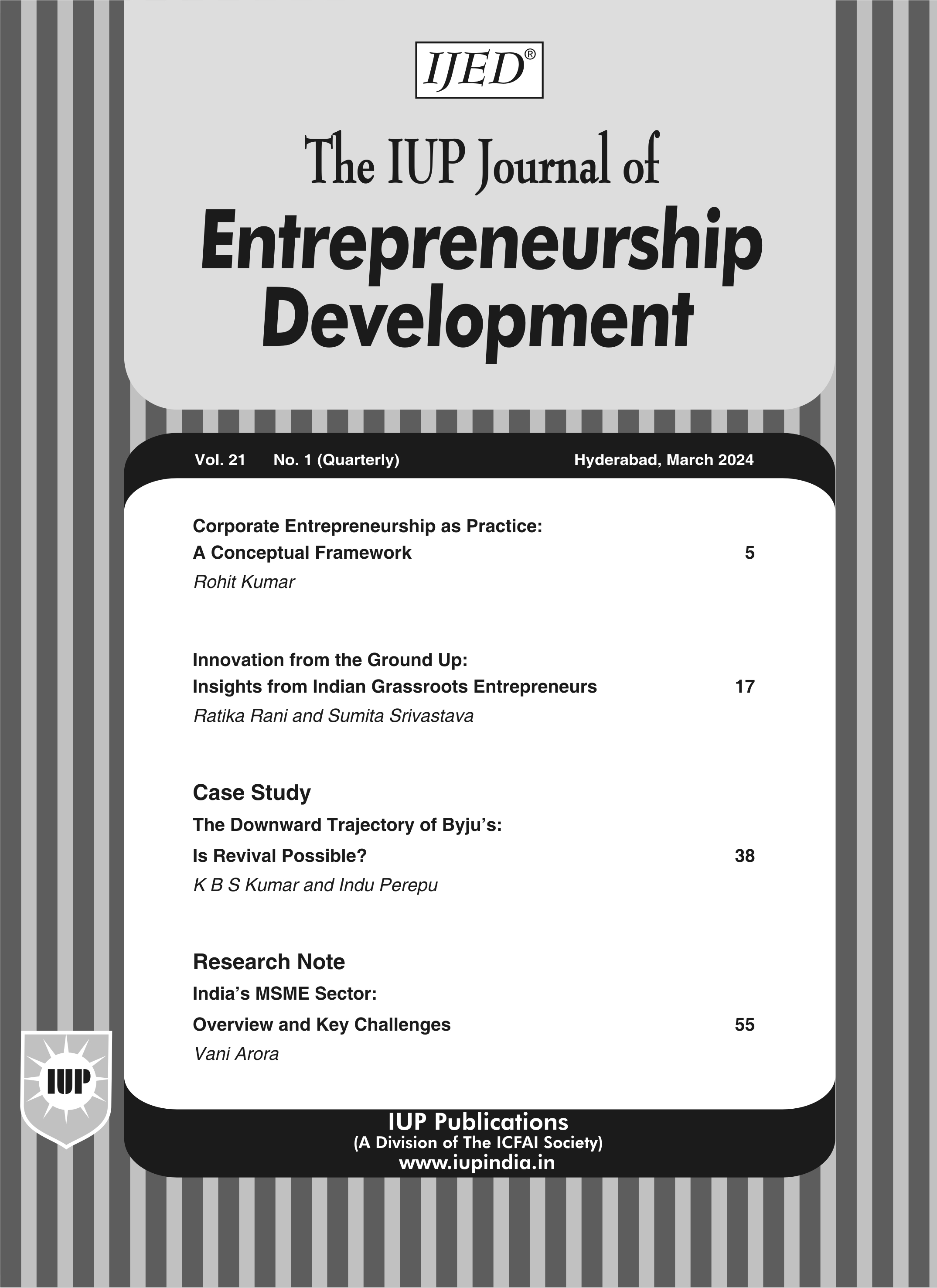
June'20
The IUP Journal of Entrepreneurship Development
Archives
Visionary Leadership and Entrepreneurial Vision Within Entrepreneurship
Muziwandile Sibusiso Sibeko
MBA Student, WITS Business School, University of the Witwatersrand, Johannesburg, South Africa.
E-mail: ntsibanzi@yahoo.com
Brian Barnard
Researcher, WITS Business School, University of the Witwatersrand, Johannesburg, South Africa; and is the corresponding author. E-mail: barnard.b@polka.co.za
This study investigates how entrepreneurs and visionary leaders formulate a vision, how they think about vision, how visions arise and what should constitute a sound vision. The literature emphasizes the importance of visions or visioning as a core component of entrepreneurship, leadership, and strategy, and it showed a strong link between vision(ing) and innovation. The literature also suggests that there are several attributes of visions, as well as many vision types that may potentially segment the entrepreneurs? visions. A qualitative approach was used for this study and interviews were carried out with experienced entrepreneurs. The study found that entrepreneurs generally have visions regarding their business ventures and opportunities. Most visions are structured, even though there are certain instances where visions are unstructured and spontaneous. Entrepreneurs regard the visioning process as crucial for their success and the consensus among the entrepreneurs interviewed is that visioning as a core competency can be developed.
Introduction
Elenkov et al. (2005) define strategic leadership as the process of forming a vision for the future, communicating it to subordinates, stimulating and motivating followers, and engaging in strategy supportive exchanges with peers and subordinates. Ireland and Hitt (1999) perceive strategic leadership as a person?s ability to anticipate, envision, maintain flexibility, think strategically, and work with others to initiate changes that will create a viable future for the organization. According to Mumford et al. (2007), a vision is seen to involve the construction of an idealized, prescriptive, mental model of the social system at hand. Unlike a plan, this prescriptive mental model may not be attainable. However, it provides guidelines for leader action. Correspondingly, it is commonly noted or mentioned that entrepreneurs carry a vision in their mind that they would like to realize, that they are driven by and that they set their actions by this vision. With regard to visionary leadership, little is still known as to how visions arise, how visions are essentially formed, and what would constitute a sound vision?i.e., how to assess vision. The purpose of the study is to examine how entrepreneurs form vision and how they think about vision.
As such, the study addresses the following research question: What comprises an entrepreneurial vision? In particular, the following sub-problems are covered:
- What are the characteristics of entrepreneurs? visions?
- How do entrepreneurs formulate vision?
- To what extent are visions or visioning structured?
- What are the common themes or axioms of entrepreneurial vision?
The study contributes to entrepreneurship, leadership and strategy theory. Visions or visioning is a core component of entrepreneurship, leadership, and strategy, and it is believed that there is a strong link between vision(ing) and innovation.
The study predominantly focuses on entrepreneurship visioning. Also, it focuses on experienced entrepreneurs, as experienced entrepreneurs ought to have greater experience and expertise when it comes to vision(ing). The study examines the perceptions of experienced entrepreneurs with regard to vision and visioning.
Similar to strategy, the study assumes that entrepreneurs? visions and visioning are not altogether random, or purely impulsive or spontaneous. Although it may be intuitive to the extent that innovation is (also) intuitive, there is a substantial degree of structure to it, and it is also formed by the knowledge and experience of the entrepreneur. As such, entrepreneurial visions and visioning contain patterns, and so forth, that may be studied.
Literature Review
A vision is defined as ?an ideal and unique image of the future? (Holstius and Malaska, 2014, p. 36). Johnson et al. (2017, p. 4), define a strategy as ?the long-term direction of an organization?. Therefore, vision gives the organization a clear sense of direction. Mission, on the other hand, defines the role that the organization wants to play (Holstius and Malaska, 2014). A mission statement outlines what the organization is fundamentally there to do (Johnson et al., 2017).
Strategic thinking is critical in the way business is conducted. Companies tend to water down the meaning of the word ?strategy? by using it as a synonym of important. A strategy is more than that; it is what differentiates between rival forces. The author differentiates between strategy and tactics. In this regard, strategy forms the plan of war and tactics are day-to-day action decisions taken (Holstius and Malaska, 2014).
Strategic thinking is essential for solving problems and meeting challenges that emanate from issues of uncertainty and unpredictability of the business environment. Strategic thinking requires rationality, and there are two kinds of rationalities, i.e., deliberate rationality and systematic rationality. Deliberate rationality governs planning and management, whereas, systematic rationality governs unknown and off control events (Holstius and Malaska, 2014).
Visionary management is vital for ethical decision making. It is running a business based on a clear vision of what the business should be, considering a changing business environment (Holstius and Malaska, 2014).
Defining Vision
Vision and charisma are two new traits for transformational leadership. According to Bass?s Model of Transformational Leadership, there are four behavioral components. These behavioral components are idealized influence, inspirational motivation, individualized consideration, and intellectual stimulation. Lack of discriminant validity of the four-transformational behavior leads to the proposal that, they should be replaced with charisma and vision (Khatri, 2005).
In these new traits of transformational leadership, vision is treated as a subcomponent of charisma. Therefore, leaders that are both visionary and charismatic are said to be transformational leaders. What is important is that these leaders can communicate their visions by linking it with the follower?s innermost desires and thereby giving followers more inspiration to work towards it (Khatri, 2005).
Visionary companies outperformed the market two times when compared to others. Leaders of visionary companies tend to concentrate on building the organization and not just the right products. Visionary companies are driven by progress, have high ideals and pragmatic self-interest, set big goals, make bold moves, use experimentation, opportunism and accident, have cult-like characteristics and are tremendous at talent management and promoting talent from within the organization (Collins and Porras, 2005).
According to Wilson (1992, p. 18), vision is a ?coherent and powerful statement of what the business should aim to become?. Vision helps companies to establish a direction in difficult and uncertain times. Strategic vision is compelling because it gives both a direction and a destination for the organization and it aids strategic implementation (Wilson, 1992).
Lipton (1996) also emphasizes the importance of the vision. It improves performance, promotes change, provides the basis for a strategic plan and motivates and facilitates recruitment of talent. For a vision to be successful, it needs to paint a vivid picture of the future of the organization. A strong vision gives followers a feeling of significance. Visions of successful organizations communicate elements of mission, strategy and organizational culture. Visions fail because of several reasons. Visions fail when senior managers? behavior does not line up with a vision. Therefore, managers need to walk the talk. Visions also fail when they are created in a vacuum, which ignores the needs of the followers. In this instance, a vision can become irrelevant (Lipton, 1996).
Malaska and Holstius (1999) describe visionary management as a future-oriented leadership process. The aim is to create new business ideas and motivate key personnel to work together as a team. Shipley (2002) describes visioning as a process of creating a view of the future. Kantabutra (2010) asserts that a well-articulated vision will make the organization to gain a competitive advantage over other organizations lacking vision. Effective visions are characterized by being brief, clear, challenging, future-oriented, abstract and inspirational (Kantabutra, 2010).
Amarasingam (2008) equates futurology to a religious movement. Both have charismatic leaders, authoritative text and hope for salvation. Levin (2000) highlights how vision is sometimes confused with mission, strategy, philosophy and values. Vision is described as a clear description of the company?s desired future. Vision orients the organization by providing a connection to a sense of purpose and meaning. Also, it gives inspiration in times of change and disruption (Levin, 2000).
Vision and Leadership
Zohar (2005) also believes that the kind of vision that the leader has will make him or her a great leader. However, there is a one-sided emphasis on material capital in the form of short-term financial gains. Organizations can experience long-term sustainability if the leadership pursues social and spiritual capital as well. Spiritual capital is about what the organization believes in, aspires to and takes responsibility for as its purpose for existence. Spiritual capital correlates with spiritual intelligence. A spiritually intelligent leader is self-aware, vision and value-led, and compassionate amongst other things (Zohar, 2005).
The leadership style is essential in achieving the organizational goal and encouraging high performance. Visionary leaders create a strategic vision of organization?s future state and encourage commitment towards it. Transactional leaders also help the organization reach organizational objective through linking job performance and rewards and ensuring the employees have the resources they need to complete their tasks (Jing and Avery, 2008). Larwood et al. (1995) state that vision is equivalent to a form of leadership. Visionary leaders can change organizational culture. Vision is therefore vital for strategy implementation and change (Larwood et al., 1995). Westley and Mintzberg (1989, p. 30) describe strategic vision as ?part style, part process, part content, and part context?. Visionary leadership is regarded as an interaction of repetition, representation and assistance. That is why visionary leaders can inspire the impossible (Westley and Mintzberg, 1989).
According to Dwivedi (2006), visionary leadership is key to corporate survival and success in turbulent environments. Visionary leaders are both transformational and inspirational. A clear vision is at the cover of visionary leadership. Its key characteristics include leading in the front, benevolence and pluralism amongst others. Collaboration is encouraged in the organization (Dwivedi, 2006).
Vision and Uncertainty
According to Courtney et al. (1997), the strategy needs to be informed by analysis. There are limitations to using traditional analytical tools to inform strategy. Therefore, Courtney et al. (1997) propose decision analysis and scenario planning, due to the level of uncertainty facing the company. The high levels of uncertainty require the leadership to think rigorously and systematically about uncertainty (Courtney et al., 1997).
Vision and Context
In formulating a strategic vision, organizations need to understand the history and structure of the industry they are operating in. Also, they need to understand the organization?s capabilities as well as the capabilities of their competitors. Leaders need to follow the four-step framework in order to answer business strategy questions: (1) generate broad scenarios of possible futures; (2) conduct competitive analysis; (3) conduct company and competitor capabilities analysis; and (4) develop a strategic vision and strategic options (Schoemaker, 1992).
According to Vecchiato and Roveda (2010), emerging drivers of change should be considered in the process of formulating business strategy. New technologies, social, economic, ecological, political events, and emerging trends should be monitored and investigated. A strategic analysis should begin with a high-level view of full implications and consequences of discontinuous drivers of change in order to consider new configuration to match changes in these drivers (Vecchiato and Roveda, 2010).
Gooday (1998) argues that users are relevant in the social shaping and consumption of information technology. They can accept or resist change, and this means that they are a significant determinant of IT?s future than the producers. Therefore, according to Gooday (1998), it is essential to study the social-cultural dynamics of diverse technology users before determining the future of IT.
Nonaka and Peltokorpi (2006) propose that a dynamic synthesis of vision is needed to implement successful knowledge management practices. Visions-led knowledge management practices were implemented in Eisai, a Japanese pharmaceutical company. These practices showed how important it is to encourage employee participation in the implementation of knowledge management practices (Nonaka and Peltokorpi, 2006).
Vision and Foresight
Strategic foresight is defined as the ?ability to create and maintain a high quality, coherent and functional forward view and to use the insights arising in organizationally useful ways? (Slaughter, 1997, p. 1). Strategic foresight is necessary because of uncertainty and rapid changes in business and the world. Selecting the right futures foresight methodologies is essential. Visioning is a process which requires the use of simple scenarios (Slaughter, 1997).
Futures studies work together in a coordinated manner with strategic planning units to enable organizations to operate strategically. Futures research constitute of extended, high-level, data-driven research work. Futures studies analyze how current ideas, feelings, goals amongst other things influence the future. As a result, the futures studies are regarded as more of social science (Slaughter, 1996).
Backcasting scenario analysis is proposed for futures studies of possible alternative futures. This scenario analysis is useful for changes over 20-100 years into the future and can be applied to human activity. Large-scale computer models should be used to model the backcasting analyses (Robinson, 1990).
Heger and Rohrbeck (2012) argue that organizations need to explore, plan, and develop new business fields to maintain their long-term competitiveness. In using strategic foresight to develop a strategic vision, the following need to be considered: (1) integrate multiple views; (2) high level of participation by major stakeholders and decision makers; (3) survive high levels of uncertainty; and (4) account for interdependencies (Heger and Rohrbeck, 2012).
Vision and Disruption
Disruptive technology is essential in strategy formulation. Firms with visionary leaders tend to thrive on technological change and develop into long-term market leaders. They innovate continuously and are willing to cannibalize their current assets for future potential (Tellis, 2006).
Christensen (2013) depicts how persistent, rapid and unrelenting the changes in technology, market structure, global scope and vertical integration have been over the years. When it comes to these changes, the paradox is that the company could be listening and responding to customers and succeed or fail. This paradox is referred to as an innovator?s dilemma (Christensen, 2013).
Vision Orientations
The nine generic visions are described below: (1) transcend (go beyond, redefine the boundaries), (2) extend (expand, grow, leverage, riding waves), (3) position, (4) restructure (reposition, redefine, adapt), (5) goals or values, (6) differentiate (standing out, being different, breakaway), (7) integrate, (8) construct (build up, improve, better), and (9) shape (steer, direct, guide).
Transcend
Collins and Porras (2005) indicate that a visionary company is a premier organization in its field mainly because of its long-term impact on the world. Visionary companies couple ideology (not just profits) with a relentless drive to succeed and as a result, stay out in the front. Visionary companies do not wait for change to be forced upon them but instead are driven to progress, to go further and do better (Collins and Porras, 2005). Tellis (2006) argues that companies that remain long-term market leaders do it by focusing intently on what they consider as the future emerging mass markets. In response to that, they innovate tirelessly to cater to that foreseen emerging market. In the process of innovation, they are even willing to cannibalize their current assets to realize that future growth potential they want.
Slaughter (1996) notes that human beings have this ability inside them to speculate, foresight and choose between alternatives. Therefore, leaders as human beings also have this ability. Slaughter (1996) notes that as a teenager when he read science fiction, he learned a great deal of grammar of futures imagery that helped him see an immense variety of images, meanings and possibilities. Therefore, futures studies become a distinct discussion that links futures dimension with the present to chart the organization?s direction with outcomes and scenarios.
Kurzweil discusses the work of a charismatic leader in futurology. Kurzweil lays out a vision of the future where people will have a longer lifespan and an option of immortality.
Initially, Artificial Intelligence (AI) will form a part of how humans live. The next phase is expected to see machines (computers) exceeding the intelligence of humans. Kurzweil coins this the age of spiritual intelligence. In this stage, computers will read literature and multimedia material and create new knowledge independently. The next stage according to Kurzweil is the singularity. In this state, humans will transcend biology. In this stage, human lifespan will be extended by technology, if not made immortal.
Extend
Kim and Mauborgne (2004) state that when corporates have grown extensively ahead of the rest of the industry, managers at that point tend to resist further innovation. Instead, Kim and Mauborgne (2004) advocate that companies should concentrate on expanding geographically and invest in operational improvements to achieve greater economies of scale and market penetration. They use Bert Claeys (Belgian movie theater operator company) to illustrate the above-stated concept.
In Belgium during the 1980s, Cinema Operators (COs) were struggling as moviegoers declined and some COs were forced even to shut down. In response COs started turning their cinemas into multiplexes; Bert Claeys went a step further by creating the world?s first megaplex. The megaplex which was called Kinepolis offered moviegoers a superior experience. After this success, Bert Claeys rapidly rolled out and improved its megaplex concept initially in Antwerp and in many countries in Europe and Asia. Other companies like Accor who followed the same approach have built more than 300 Formule 1 hotels across Australia, Africa and Europe.
Tiwari et al. (2006) argue that many of the services offered by mobile commerce
(m-commerce) can be offered using other platforms such as the ?immobile? (stationary) internet, e.g., purchasing tickets to a football match. M-commerce has this advantage of using Location-Based Services (LBS) that the ?immobile? internet cannot offer and this, in turn, opens new business opportunities. To illustrate this advantage, a user can locate the nearest Automatic Teller Machine (ATM) in real time by the determination of his current geographic position.
Vecchiato and Roveda (2010) argue that it is the introduction of 1G technology and 2G technology that allowed people to do more than use their phones to communicate while moving. Personal and private calls could be made since people?s contents could be kept just for the people addressed. 1G technology gave the cellular phone a new meaning, and 2G technologies allowed it to boom, in the process cutting the cost of both the services and the products. These technologies opened the door to mass cellular phone consumption.
Levin (2000) notes that businesses can expand or modify their mission to reflect shifts in business focus. These shifts can also happen at an industry level. Hilton changed its business focus to entertainment business from the business of hotel and lodging, and Greyhound extends its business from buses to transportation. Industry level shifts are evident in many healthcare organizations that are extending their business emphasis from offering illness and disease management services to wellness and prevention services. Banks are also morphing into a more comprehensive financial services centers.
Mic? et al. (2009) argues that since the acceleration of trends in media ownership concentration and cross-media partnerships, media companies have been exploring convergence in news production. As an example of such convergence is Grupo Segre, which was created from the foundations of Prensa Leridana, a company that publishes the newspaper and launched Segre Radio. The company has since grown to become one of the major operators in the region. Segre was active in the free press through its local edition of the daily paper ADN. Another example is of a company called Group A Tarde (Salvador/Bahia).
This local media company underwent a substantial change since 2006, aimed at consolidating and expanding their diverse and complementary media outlets for the distribution of local content to meet the diverse needs of their regional audience. The convergence strategy transformed A Tarde from a traditional newspaper in the province of Bahia, to being Group A Tarde, owning A Tarde newspaper, R?dio A Tarde FM, Portal A Tarde On-Line, Web TV A Tarde On-Line, Revista Muito, Ag?ncia de Not?cias A Tarde and A Tarde Mobile. The group was planning to move into digital TV.
Position
Wilson (1992) notes that a company?s choice of business scope (i.e., the range and mix of businesses) requires for more than a slight rearranging of business lines. It improves the company?s strategic focus and outline target areas for both diversification and divestiture. All at the same demand the leadership to make some tough strategic decisions. An example is how Jack Welch opted to divest General Electric of the resource businesses of Utah International, mainly because they no longer fitted into Welch?s strategic vision. The decision was not made because the business was unprofitable, but because it wanted to improve its profits. Therefore, a key element of vision is that businesses should be able and willing to cut out some things, as well as cut-in other things. This element of vision is discriminating. The former Foremost-McKesson chose to focus on value-added distribution services to pharmacists, while discriminating against the company?s ?heritage? business through disinvesting and changed the company?s name to McKesson Corporation.
Vecchiato and Roveda (2010) note that in the early 1980s the demand for coffee was significantly impacted by the widespread adoption of a healthier lifestyle. The healthier lifestyle movement led to people replacing alcohol with coffee and increased the consumers? awareness of this coffee. The demand for coffee increased. A change in lifestyle patterns and the emergence of a new socialization pattern from dance clubs to people choosing to gather together in quite locations was another driver of change that affected the industry more radically. This new pattern of socialization also changed the need for coffee as it became more than a need for a drink but rather a need for a social experience. Howard Shultz who is the founder of Starbucks took advantage of this change started the Starbuck venture, positioning it to give its customers around the world the ?Starbuck experience?.
Vecchiato and Roveda (2010) note that also in the 1980s and 1990s the spectacles industry was another industry that underwent a deep transformation. The main drivers of the transformation were: the development of celluloid and aesthetic research. Fashion designer gained interest in using commonly-used objects in everyday life such as spectacles to ?dress? customers? eyes and improve this essential feature of their look and personality. Luxottica positioned itself to take advantage of this trend by combining technology and fashion to produce spectacles that became more of a fashion accessory to their buyers.
Vecchiato and Roveda (2010) continue to state that this trend in the spectacles industry led to a radical shift in the industry structure and its attractiveness. Companies started competing more on product design and brand identification, and therefore spectacles manufacturers had to renew their image accordingly. Contact lenses and surgery to correct eyesight defects were no longer considered dangerous substitute product or service. The growth in the market was driven by customers wanting different spectacles to go with their different look throughout the day. In this context, Luxottica?s success and market leadership position was attributed to its understanding of customers? new needs for spectacles.
Holstius and Malaska (2014) note that Koji Kobayashi who became a CEO of Nippon Electric Co. (NEC) in 1976 was regarded as an early pioneer and visionary leader. Koji was able to foresee the coming era of the information society, that there will be a need for engineering and business solutions. NEC positioned itself to advance the realization of this vision by providing the needed solutions. Kobayashi?s belief that communications should create the conditions under which anyone, anywhere, can talk with anyone else at any time allowed NEC to be a leading business in Japan?s telecommunications industry and the world. NEC supplied products to more than 130 countries and maintained production facilities in 12 countries.
Further to this, NEC entered the computer to supplement its communications solution and started developing several breakthrough technologies for the market. This new vision was called Computers and Communication (C&C). Kobayashi also saw an opportunity for the technology to progress more closely to human needs. This led to the new step of the vision as Man and C&C, which sought to improve the man-machine interface, stressing the importance of progress in software technology and media technology. This renewed vision was expressed as all humankind exchanging information and using information collectively.
Restructure
Lipton (1996) states that Robert Eaton, who replaced Lee Iacocca at Chrysler, despite shunning the notion of a vision statement, was able to change the culture at Chrysler. The culture change at Chrysler emphasizes quality, decentralization, speed in decision making, open communication, and initiative. This culture also makes provision for the learner cyclical periods. Eaton was able to restructure things at Chrysler through communicating naturally about what the future of the company?s management must look and feel.
Westley and Mintzberg (1989) analyzed that Lee Iacocca?s leadership in the Chrysler turnaround suggests that he used metaphors to unite stakeholders behind him and that empowered the implementation of his strategic initiatives. Westley and Mintzberg (1989) argue that, however, Lee Iacocca focused on a classic form of operating, not necessarily a strategic turnaround and engaged in cost cuts, reorganization, rationalizing, etc., rather than conceiving a new image of how the company should compete in the automobile industry. Iacocca was mainly interested in preserving the status quo rather than engaging in radical change.
Heger and Rohrbeck (2012) propose that companies such as Nokia are trendsetters when it comes to businesses moving into new business fields. Nokia was able to successfully change from being a pulp and paper company, which produced rubber boots and tires to becoming the world?s leading manufacturer of mobile phones. Nokia is once again at the brink of restructuring itself into becoming a service company, which would be the third major transition and the third time that the company has moved into a new business field.
Courtney et al. (1997) argue that companies classified as adapters assume the current industry structure and the projected future evolution as cast in stone. Adapters can quickly respond and capitalize on market developments and the opportunities the market offers. This response is the adapters? special form of adapting. The strategic posture of these companies is to reserve the right to play a leadership role by incrementally investing in the company. Incremental investments can either be on the attainment of superior information, the restructuring of cost structures, or the improvement of customers and suppliers? relationship. That strategic posture is essential in an uncertain environment. Therefore, Courtney et al. (1997) advise that the company should wait until the environment becomes less uncertain before formulating a strategy.
Levin (2000) shows how Hilton restructured. It changed its business focus from the hotel and lodging business into the entertainment business. Greyhound also restructured in a sense that it expanded from being the bus business into the transportation business. As stated above, such a shift can also occur at an industry level. An example of this is how healthcare organizations were restructuring themselves from a focus on services directed at illness and disease management into wellness and prevention. Banks are also constantly restructuring themselves into offering more comprehensive financial services.
Values and Goals
Collins and Porras (2005) warn that core ideologies should not be confused with non-core practices or products. As an example, IBM started stumbling when failed to abide by its ?three basic beliefs? of respecting employees, making customers happy, and working hard to do things right. These were replaced with a new emphasis on mainframe computers, blue suits, and white shirts and all of these were non-core values. On the other hand, Wal-Mart?s core belief of ?exceed customer expectations? has been made permanent and unchanging. Boeing?s core values were that of ?being in the leading edge of aviation; being pioneers?. Boeing?s core value is also permanent. All else can change in terms of business practices. Collins and Porras (2005) argue that business, strategy and tactics, operations, culture, and products can change over time, but core ideology should not change.
Shipley (2002) states that psychologists have conducted studies showing that specific and challenging goals led to better performance than the lackluster type goals. There is a correlation between goal specificity and task performance. Therefore, they concluded that the clearer the statement of the goal the higher the chances of it being attained.
Wilson (1992) notes that, by the power of his vision and leadership, Jan Carlzon was able to unite the company behind a single, logical goal that everyone could understand and back. As a result, a company that was in a financial crisis succeeded against the odds and started making profits. His vision was that: ?We must become profitable, not by buying and selling aircraft, but by being a service-oriented company that earns its money by being number one at service? (Wilson, 1992, p. 26).
Collins and Porras (2005) argue that if the company wants to stimulate progress, it needs to set what is called ?Big, Hairy, Audacious Goals (BHAGs)?. Boeing did the same when it needed to survive in 1952 by entering the commercial aviation industry. A good BHAG can live beyond the leader and take on a life of its own, as we see how Boeing in one of the big players in the commercial aircraft manufacturing industry. Wal-Mart?s Sam Walton also did the same, he set a goal to become a $125 bn company by 2000, and he knew that his goal would outlive him. Ford also used BHAGs when it set a goal to develop an entirely new, world-class car. Ford invested massively towards this goal to a tune of $3.25 bn budget. The result is the Taurus/Sable which were considered as some of the bestselling cars in the US.
Westley and Mintzberg (1989) describe how Edwin Land who invented the Polaroid camera was inspired by her daughter to invent the camera that would give a picture immediately after exposure. Her daughter set this BHAG. After Edwin Land?s invention of the instant camera, his focus, which also became the core for his strategic vision was to further develop and perfect the instant camera technology.
Differentiation
According to Kim and Mauborgne (2004), through a strategic logic called value innovation, high growth companies can make their competitors irrelevant. Value creation seeks superior value for buyer and lower cost for the company. Companies that frame their strategic logic around value innovations consider the following: (1) Factors taken for granted by the industry, (2) Factors demoted below the standard of the industry, (3) Factors elevated above the standard of the industry, and (4) Factors that should be created that were never offered (Kim and Mauborgne, 2004).
Kim and Mauborgne (2004) argue that value innovators are curious about ?new start? scenarios. They aimed to create massive gains in customer value creation, through forgetting the past, the current industry rules, practices, and traditions. Value innovators ensured a radically different value curve vis-?-vis competitor, and most customers valued the difference. Innovative companies seek to enter new markets, through creating products or services that are differentiated from competitors. The companies go beyond the conventional boundaries of industry competition, as managers search methodically to find uncharted markets that represent real value innovation.
Nonaka and Peltokorpi (2006) state that Eisai?s vision is a commitment to viewing healthcare from not only the standpoint of the healthcare professional but also from that of the patient. The implementation of this vision in 1989 marked a shift in thinking in the Japanese pharmaceuticals industry, which was more focused on doctors and pharmacists than on patients. With this reorientation, Naito focused on improving the overall quality of life.
Kim and Mauborgne (2004) note that in Belgium when the movie theater industry constrained, moviegoers were not visiting the movie theaters as they used to due to growing popularity of other entertainment products (i.e., videocassette recorders and satellite and cable television). In response to this, Kinepolis offered moviegoers the world?s first megaplex, and this gave them a radically superior experience. As a result, Kinepolis was able to capture 50% of the market in Brussels in its first year and then decided to expand the market by a further 40%. The company?s strategy was to make its cinema experience completely different from what the competitors were offering and utterly irresistible. The company?s strategy of fighting for the market like as if it were a new entrant into the market, proved to be a success.
Kim and Mauborgne (2004) recall that, for years, the major US television networks used monotonous news programming. There was no innovation that was until CNN joined the scene in 1980. CNN?s strategy was to focus on creating a superior value, by not competing with other networks, but merely changing the networks? format with real-time news from around the world, aired 24 hours a day. This strategy worked because CNN became the leader in global news broadcasting and even created new demand around the globe. CNN was also airing 24 hours of real-time news at a fifth of the cost of what it cost another network?s news in one hour.
Integrate
Information technology and multimedia-based technologies are bringing about transformation in the multimedia business industry. There is an increase in the expansion and effective use of the so-called information super highway which gives companies a competitive advantage. The convergence process is driving change in the media and communication industry, even as multimedia cooperative arrangements are emerging. Companies that pursue a focusing strategy are founded upon rigid vertical corporate strategies at times (Wirtz, 1999).
The Brazilian and Spanish media corporations have also gone through a media convergence process. In Spain, Catalan Media went through this multidimensional convergence process, which resulted in the integration to produce news content distributable through numerous platforms. This is an example of how a strategic vision can influence business models to transform and a new journalistic model with a new way of generating revenue (Mic? et al., 2009).
The media industry is being disrupted as several trends are changing the way business is done in the industry. Media convergence is one of those trends. It achieves through digitization of news production systems. Convergence has grown to the status of being regarded as a strategic option for media companies. The convergence process is characterized by ?cooperation and collaboration between different types of media? (Avil?s and Carvajal, 2008, p. 222). This allowed media companies to improve the quality of journalism and reduce production costs. As a business strategy, collaboration and partnership among multimedia companies can result in convergence (Avil?s and Carvajal, 2008).
Tiwari et al. (2006) argue that mobile commerce is becoming more and more accepted. There is a convergence of information technology and telecommunications which is driving the mobile commerce boom, motivated by the need for mobility. This provides several value-added services to customers and business opportunities for technology providers (Tiwari
et al., 2006).
Construct
Nonaka and Peltokorpi (2006) argue that phronetic leadership is the reason why some companies can create and inculcate good absolute values in their organization. Phronesis is the ?virtuous habit of making decisions and taking actions that serve the common good? (Nonaka and Peltokorpi, 2006). It is a combination of universal knowledge and events that produces insight into the implications of actions and an action plan. This is an essential concept in corporations because it allows them to self-introspect on more than the profits that they make but to look further into the good of the community. That is why leaders with phronesis are ethical and virtuous.
Kantabutra (2010) note that some companies can have their vision stemming from the brand. An example put forward is that of BMW, which did not have an explicit vision statement for many years. Now the BMW brand is what drives employees to maintain the high quality and excellence associated with it.
Westley and Mintzberg (1989) state that the term bricoleur refers a man in France who was known for frequenting junkyards, and there he picks up the stray bits and pieces which he then artistically puts together to make new objects. This term can also be used to suggest that the capacity of visionaries for building, concerns building up organizations, teams, designs, or ideologies. The bricoleur?s genius goes beyond the introspective ability to invent or imagine, but instead moves into a space of interactive, social ability to read situations. It also means that these leaders can recognize the essential, they understand and deal with people and can project these essential understandings into the future foresight. Lee Iacocca was cited as one of those institution builders. Lee could incrementally piece together people, parts and processes. Iacocca can be regarded as the inductive strategist who combines the different pieces to create the whole.
Shape
Courtney et al. (1997) argue that when companies are facing uncertainty, they have a choice to take the following three strategic postures: (1) shaping, (2) adapting, and (3) reserving the right to play. Second, they can move their portfolio in three ways: they can take big bets, options, and no-regrets moves. Therefore, Courtney et al. (1997, p. 8) define strategic posture as ?the intent of a strategy relative to the current and future state of an industry?. In dealing with uncertainty, shapers strive to change their industries into a new form. Therefore, shapers? strategies concentrate around creating new in market opportunities. They can disturb relatively stable industries or control highly volatile market industries.
Gooday (1998) argues that Bill Gates, Steve Jobs and Steve Wozniak who can be regarded as shapers, drew upon popular culture and commerce to find useful purposes for the proto-PC to serve. The esoteric Altair 8800 electronic kit computer was used in 1975 and Windows operating multipurpose PC was used in the 1990s. This is how shapers think and how the shaping element of vision was implemented in the past. They were able to mold a microcomputer into whatever multiform role that could be marketed to fit into the daily social existence of businesses, educational establishments and affluent populations.
Courtney et al. (1997) note that the company?s strategy can create uncertainty for itself. An example was Federal Express which entered a stable mail-and-package delivery industry at a time when several potential demands for overnight services existed. However, when FedEx started offering overnight services, FedEx created uncertainty. Other industry players were prompted to follow suit. As the industry gradually returned to stability, fundamentally new structures had already emerged. Therefore, FedEx?s risky bet paid off, which in turn forced the rest of the industry to adapt to the new overnight services demand.
The literature suggests that there are several attributes of visions, as well as many vision types that may potentially segment the entrepreneurs? visions. It suggests that visions are far more structured than impulsive or ungrounded. Visions and visioning should then also encourage innovation and creativity. Questions remain as to (1) the relationship between opportunity and visions, (2) the significance or value of visions?in essence, whether visioning can be seen as a core competency or competitive advantage, as well as (3) the development of visioning, should it be a core competency.
Data and Methodology
Research Paradigm
Ketchen et al. (2006) note the controversy among strategy researchers that has surrounded the choice between quantitative and qualitative method. In the strategy field of research, researchers tend to use both quantitative and qualitative approaches; however, the use of quantitatively-operationalized research designs is dominant. Kalof et al. (2008) indicate that there are two main research approaches and those are qualitative and quantitative researches. Creswell (2014) introduces another research approach, called a mixed method approach.
Quantitative research is a research method that uses statistical, mathematical and computation techniques to conduct an imperial investigation of observable phenomena (Given, 2008). This method uses mathematical models, theories and hypothesis testing about what is being measured or observed. This process produces quantitative data, which is defined as data that can be expressed numerically or explained by some numerical value (Crowther and Lancaster, 2009).
Qualitative research is referred to as social constructivism or interpretivism as it seeks to understand observations to gather non-numeric data (Babbie, 2014). These observations are the ?subjective meanings, concepts definitions, characteristics, metaphors, symbols, and description of things? that people have on the subject (Creswell, 2014, p. 4). This research will use qualitative research, because the method is more concerned with understanding smaller samples in greater detail, and it allows for flexible examination of the observation. That is why a qualitative approach was preferred for this research, as it aims to acquire insight into the personal viewpoints and perceptions of experienced entrepreneurs, which provided for more in-depth knowledge of leadership, vision and innovation.
Research Design
The research was conducted using the semi-structured interviewing methodology. Darlington et al. (2002) define the semi-structured interview as the method of research most commonly used in social sciences that uses a framework of themes to be observed. This is different from a structured-interview because it is open and does not have a rigorous set of rigid questions. Entrepreneurs that were interviewed were able to bring new insight through their responses. Also, the semi-structured interview is the most widely used method of data collection in qualitative research.
Bell (2005) outlines the following benefits of using semi-structured interviews:
- The interviewing process gives a set of responses that can be easily recorded, further summarized and analyzed.
- Encourages focused conversation and two-way communication.
- There is flexibility to ask for more details and to discuss issues, as questions can be raised during the interview process. This also facilitates deeper insight into the discussion.
- Questions and the topic under discussion can be developed further arising from the interview process.
- They need a skilled interviewer, who will avoid leading questions and who has excellent listening skills.
- Switching between focused and open-ended questioning might be a challenge.
- Some interviewees might want to treat specific responses confidential.
- Several extra insights that surface during the interview will require additional analyses to sift through to check for similarities in responses.
Population and Sample
Bell (2005) defines the population as the group or category of individuals selected for a study. The population for this study constituted entrepreneurs within South Africa.
Blaxter (2010) states that sampling is not only limited to a survey approach and can involve other approaches. Blaxter (2010) defines two main groups: probability and non-probability sampling. This study follows a non-probability sampling strategy called purposive sampling. This sampling strategy entails hand-picking both typical and interesting candidates (Blaxter, 2010). Kalof et al. (2008) warn that in purposive sampling, a researcher should be careful not to choose candidates that support a viewpoint.
However, entrepreneurs were selected based on their experience. Despite the potential bias or weakness in the generalization of the results, the targeted sample was informative, possessing the necessary experience and knowledge to able to reflect on the topic appropriately.
The selection met the following criteria:
- A minimum of three years? experience in the business.
- A minimum of one successful business or partnership.
A total of 10 entrepreneurs were selected to participate in the study. It is believed that saturation occurs beyond this point so that no new insights can be gained from additional interviews.
Research Instrument
Data collection was conducted through an interview schedule (see Appendix). Darlington et al. (2002) encourage the use of an interview schedule as it ensures that the semi-structured interview is aligned to the core elements or framework of the research. Willig (2008) notes questions should be well thought out and that they should cover the contents of the literature review to ensure relevant insights are gained through the interview process.
Data Collection
The data was collected through face-to-face interviews. Interview appointments were made based on the participant?s suitable time and preferred location (Darlington et al., 2002).
Before the interview, a letter of indemnity was read and issued for a read to sign off. It included the details of the interviews such as:
- Intent of research
- The anonymity of the interviewee
- Duration (45 mins to 1 hr)
- Data collection method
- Ethics obligation
All interviews were recorded, and the interviewee was notified about the recording before the interview starts. Bell (2005) emphasizes that the benefits of recording must be explained to the interviewees so that they understand the reasons and put them at ease. It is important to record because it allows the interviewer to
- Pay full attention to the interviewee as note taking can cause a distraction,
- Maintain eye contact during the interview,
- Maintain the accuracy and reliability of the data collected,
- Review the data at a later stage to gain better insight.
Recording an interview has drawbacks and unintended consequences, such as limiting the extent of comfort to which the participant might like to have in sharing insights (Willig, 2008).
Data Analysis and Interpretation
Darlington et al. (2002) indicate that qualitative research data analysis can be done through various techniques. Qualitative research primarily deals with interpretivism, with the view that what we see around is the creation of the mind (Walliman, 2017). Thematic analysis is commonly used with semi-structured interviews (Ritchie et al., 2003). Thematic analysis, among other things, is about pinpointing and examining patterns within the data. Therefore, a thematic analysis was used in this study.
The refined framework method used in this study captures the deep understanding and a level of detail that is required. This framework is based on the following five-step process:
- Familiarization: Becoming familiar with the data, by listening to it, and transcribing to draw out key points, themes and noting the repetitive themes. A reflection method will be used to connect the theory and interviews.
- Identifying a Thematic Framework: The second step would be to pay attention to emerging themes, concepts and any specific groupings identified.
- Indexing: This phase aligns the data identified by the thematic framework categories and indexes the transcripts of each interview.
- Charting: This phase groups all the common themes from the thematic frameworks which allows for the combination of data to create a clearer picture. It is summarized and must maintain the original context.
- Mapping and Interpretation: In the mapping process, the essential characteristics are aligned and placed together. The dataset is then interpreted to provide a complete understanding.
Validity and Reliability
Validity
Bell (2005) states that validity in research refers to the extent to which a data collection tool measures what the researcher wishes to measure. Validity also refers to the extent to which the design of the research allows the conclusion of the research to be credible. Therefore, if the data is unreliable, then it will also lack validity, and the converse is not necessarily true. Bell (2005) distinguishes between internal and external validity. Internal validity is concerned about the level to which the research evidence supports a claim about cause and effect. External validity is the validity issue that arises from applying the conclusions of a scientific study outside the context of that study.
For this study, validity was achieved through the careful wording of the questions in the interview guide (Bell, 2005). Willig (2008) offers other techniques that were employed, concerning stipulation, continuously checking, questioning, and theoretically interpreting the findings throughout the research process. Internal validity can also be improved through pilot studies to validate the research instrument. External validity is less of a concern?the study is interested in insight than generalization.
Reliability
Bell (2005) defines reliability as a characteristic of a measurement being repeatedly able to get the same results if the tests or processes are performed under the same conditions. Articulate questions improve reliability. Helping the interviewee to stick to the questions also improves the consistency of the results obtained from the total interview process. Reliability was enforced by piloting the interview guide and ensuring that questions were worded in a manner that elicits the same responses even under different conditions and enlists the required information. Following the interview guide also helped with reliability.
Results
Prominence of Visions
The vision can be a fairly loose vision, which speaks to the level of freedom and flexibility of the vision. Freedom in the sense of not being bogged down by practicalities or realities. The vision and visioning may be affected by limited capacity and resources, for example, due to changes in organization/setup. This sometimes happens when the business is sold or started over. In such an instance, a vision for scalability and redundancy is an example of the entrepreneur focusing on things that are important and beneficial to the business. The focus is on things that will help and benefit the business.
A vision also can be a lot like a dream and almost like the ideal, whether partly or in its entirety?it is a picture of an ideal case or circumstances. In some instances, it is likened to fantasy?what would be nice and perfect. However, the vision goes beyond the fantasy stage; it is about taking care of and resolving real issues and problems in an ideal way. Visions typically do not contain issues or problems. So, in visions, issues and problems are solved and sorted by the individual or business.
In visions, things and setups are optimal. In visions, things have been adapted (to), re-configured/rearranged, and loose ends are tied up. When an entrepreneur starts to implement visions, they need to start with aspects and parts of visions that are already achievable and are beneficial. Which requires the visionary to set goals to implement and realize visions. This means that there must be a process of figuring out what needs to be implemented to realize the visions.
The vision is logical and sensible in that it must make sense and be the right or best thing to do. For some entrepreneurs, a vision can be cautionary and protective with the aim of avoiding problems and complications. Visions also allow the entrepreneur to take leaps, and to stretch. This is mainly because the visions are based on imagination or fantasy, so there are no limitations. In visions, a leap or jump that is needed for survival and prosperity is taken, and that scenario is colored in. The real and present situation is moved closer to that imaginary or fantasy scenario. In this instance, visions allow for the development of solutions to radical, critical, big issues and problems.
What this means is that a vision is very much based on the intuition and subconscious and there is a strong relationship between vision and radical innovation. These innovative visions are to solve problems, and optimally repositioning within the current context and environment. Visions therefore should, and help to, adapt to developments and (new) circumstances.
What also became clear was the fact that visions are projections of the future. This means that visions are based on possible futures, even though it is not certain futures. Perceptions of what the future could be like are created. Then the entrepreneur strives towards that vision?striving to attain that vision. Even in this context, visions may prove to be poor?stupid or not ideal?mainly because not everything was considered. Visions should ensure future continuity, survival, and prosperity.
For some entrepreneurs, visions are built on aspirations (desires). What and how they want (their) life to be. The only downfall with this is when the visionary starts to do it in excess, and starts to overlook reality. This misconstrued reality causes the entrepreneur to want to operate that way in real life too?become unrealistic and impractical?ignoring many facts. That is the flip side danger of an aspirational vision.
Visions and Opportunities
Some entrepreneurs indicated that they have come up with what they consider to be a stupid vision. Stupid visions are poor visions that are not thought through properly, not adequately devised, and poorly implemented. Poor visions may fail, just because the entrepreneur does not involve enough people during either devising the vision or implementing the vision. Therefore, the implementation of visions is essential. It must be done in an agile way?fast, with frequent management of updates, feedback, and assessment. The vision must be frequently re-evaluated and (re)assessed.
Realizing and identifying issues sooner fosters sound decision making. The decision-making process must incorporate others and their thinking (on problems/issues, and solutions). It is about getting others to solve problems and come up with solutions with you. This at the end increases the business-ownership of the vision. This approach helps in dealing with and neutralizing inevitabilities, distractions, unexpectancies, and surprises very quickly, to get back on track. The absence of a vision creates a general sense of being lost. Generally, entrepreneurs do not have purpose and direction, even strategy, without vision.
Opportunities may exist without vision. Vision requires imagination?a developed imagination and developed creativity. That imagination comes from an interest (in things or something), the ability to play and in that process develop thinking. This is speaking in general. So, there is a need to be curious. The entrepreneur needs to understand what is going on?have a good understanding. When an entrepreneur can play and be creative, the vision will emerge.
It is about having ideas and trying out ideas. One idea may lead to another as the entrepreneur gets involved. You start to push the limits and boundaries, once you are involved and have started. You start to aim higher and think bigger and develop ideas further. You extend ideas, add new and additional contexts and take on more significant challenges by recognizing problems and opportunities. You gain experience and expertise and become more advanced, sophisticated and efficient in learning about business and the industry.
For most entrepreneurs, problems precede opportunities. You start planning and understanding what is needed, and what needs attention or to be changed, and what must be developed. You build and develop expertise, reputation and influence.
Development of Visions
The vision can develop, expand, grow. However, it does not imply that it is productive or constructive. Some visions can still develop further, even though not as productive any more. In the process of the vision maturing, growth is still possible, even though at that time it can be poor growth or not attractive growth. The kind of growth might not be the one desired by the entrepreneur. In that case, it may be necessary to break with the vision then. Breaking with the vision can mean moving on to something else, that has greater potential.
Visions can develop organically. These are visions that are new in context, and thus have both great potential and growth. Therefore, an entrepreneur must find a new vision to develop and grow further. In this instance, new technology and developments can also help the visions. The question is: What is new? For some entrepreneurs this is about implementing the vision and bringing the vision down to earth, and the issues this may result in.
The progression and development of a vision can also simply be about getting the vision to survive. The fight for survival steers and guides the vision. This is important because visions face battles and competition. Therefore, it requires the entrepreneur to be smart about implementing the vision. The entrepreneur must pay attention to things that may destroy or prevent the vision, things that are subtracting from the vision, and even things that will be critical issues in the future. The entrepreneur must also pay attention to the shortcomings in terms of the vision. Also, pay attention to key things that they need to maintain to achieve the vision and keep it alive and move it forward and develop it further.
There are external and internal factors that may impact and steer the vision if the entrepreneur does not pay attention to this. This means that an entrepreneur should look after the vision and not neglect it. This requires foresight in terms of the vision. As it may work well and go well now with the vision, its survival in the future is not guaranteed. Other opportunities may surface with developments, that challenges the vision, i.e., competition, and competitive/hostile factors.
Vision requires proper implementation. Vision requires alignment with operations. Other incentives and decisions in the business should be in line with vision. Vision requires focus and commitment. An entrepreneur should not get distracted.
When contrasting visions and models, models are dependent on being comprehensive. With models, it is a matter of cautioning against putting garbage in and getting garbage out. There are aspects of developing a comprehensive model that are important, and those are mainly knowledge and understanding. The depth of thought improves comprehension. The perspective of the entrepreneur is essential in modeling. So is gaining an understanding of the perspective of others, which requires thorough deliberation. Models are also dependent on timing. Getting the timing right is crucial. There are models without vision. Vision builds on models. Models do not require vision per se. Models are only to facilitate understanding. Models are not strategic; contrary to models, visions are more strategic.
Entrepreneurs think that a vision develops and recedes. Vision depends and develops based on the local context. Practicality is a measure of an excellent visioning process. Vision must be or at least get to the point of being practical. This means that they must be holistic and balanced. Getting one part right but lacking on other parts in visioning or vision is not going to help. So, the vision must extend and expand the boundaries of thinking. This requires a paradigm shift. Paradigm shifts are a powerful change mechanism. Entrepreneurs need to introduce paradigm shifts.
Morals affect the development of vision or visioning. Some think that it is the foundation of visions. It is the foundation of good and bad thoughts or thinking. His principles and foundations determine whether the entrepreneur builds up or destroys.
Visions, Innovation and Creativity
Entrepreneurs have a choice, of whether they want to be creative or not. Some think that there has been a lot of nonsense and poor thinking around creativity. The assumption is that everyone can be creative. However, there are things about creativity that are feared; things about creativity that people shun away from; that people want to avoid. There is uncertainty in creativity, where an entrepreneur is being creative and innovating, yet not knowing if it will work or what the outcome will be. There must be a strong willingness to run with the developed ideas. There must be freedom of thinking in the thinking. Constrained thinking must be avoided. This will direct the entrepreneurs thinking and creativity.
Axioms or Building Blocks of Visions
Visions are believed to be organic. Visions bifurcate much like a decision tree. Entrepreneurs make decisions as they go. There may also be much work involved in maintaining a vision.
Entrepreneurs distinguish between formal versus informal visions. Others keep a vision but are not too serious about it. They are running with it for as long as it will hold because it is cheap and has rewards. Other visions arise out of observation and evaluation of the present, and what is happening or transpiring. Knowing what is going on around is crucial, i.e., being able to change and direct what is happening or going on in the business.
Visions arise through realizing and identifying that there is a problem and then changing that problem into an opportunity. It must be intentional. As an entrepreneur, you must be intentional about yourself too?having direction and being driven. Wanting to move forward and wanting to move things forward. The entrepreneur must look at how they can improve on the current and present situation. In a sense, also break with or away from the present (i.e., implying innovating), through looking for options and other possibilities. They must assess what they need to implement their vision, and what is standing in the way of the vision.
Implementation of the vision requires an assessment of the strengths and weaknesses of the vision?what counts for and against the vision. Even though, some entrepreneurs caution that sometimes it helps not to over-think, and to move simply. It is about burning bridges and getting pushed out of the nest and being under pressure to make a vision succeed. Entrepreneurs must be proactive, rather than reactive. So, early on they need to break with the current setup, way, system, process, etc.
Some entrepreneurs indicated that there is also some level of fortune in implementing visions, and finding out or identifying what is standing in the way of the vision, and how it can be overcome. Finding resources and people that align and agree with the vision, and that are willing to support it. Identifying how to change or realign the current system or setup to support the vision.
A structured way of developing a vision also considers developments. The fact that things change, and it impacts the vision. Therefore, an entrepreneur needs to monitor and note trends and developments, and act based on this. There are things to avert, circumvent, and flow with. So, the entrepreneur must make sure that developments align with the vision and must align the vision with developments. The exposure of the entrepreneur is vital in this instance. The higher their exposure, the higher, better, more accurate and more comprehensive will be their vision.
The development of a structured vision speaks to partnerships. Looking at whom the entrepreneur can work with. They have to detach from people or things that are keeping them and holding them behind. Knowing when to exit the vision too. When the vision has matured, is in decline, and it is time to move on to something new. Growth leads to more growth and new opportunities. Being stimulated in this way, growth and success in expanding the vision form synergies with people that complement and advance the vision.
Timing is also an important aspect to consider in developing a structured vision. This speaks to the ability to transition from the old vision to a new vision at the right time. Also aligning the vision with interests and likes, and what would fit.
Finally is the scope and boundaries of entrepreneurs and their thinking. This speaks to the extent to which the environment, context, circumstances are limiting, constricting, restricting vision, and their vision.
Quality of Visions
Entrepreneurs indicated that visions can suffer from lack and be wrong. However, they can be wrong to varying degrees. They can be wrong because of timing. Visions have finite lifetimes. Vision depends on timing and trajectories, looking at the trajectory and the trajectory of contexts, environments, circumstances, such as ?how? needs (including your own) and scenarios, contexts, environments, etc.
Some visions can lack or be wrong because of developments and trajectories. Some because of continuity and discontinuity. This speaks of being without vision or foresight. Visions can lack because of dependencies. The fact is people become dependent, when they are no longer independent?able to survive and take care of themselves. Some entrepreneurs have forgotten how to survive and solve problems. Somehow, they have handed over to systems and are dependent on systems.
Some visions are wrong or lack because they focus on quick gains, and getting ahead, and own dreams and desires like building castles in the sky. As a result, the entrepreneur does not pay attention to cracks and warning signs.
Vision as a Core Competency or Competitive Advantage
Yes, the entrepreneurs think that visioning is important. They think that it is about intuition. Having a certain sense about the business that they are in and then going with that sense. This helps them to be very agile and able to adapt. It is about observing and then adapting. This is also part of vision and visioning.
Knowing and understanding and following developments. Where things are and where things are going. Being able to respond appropriately and knowing how to take the right step at that time for that situation. Then take the next step when the time calls for it. Companies can get ahead through innovation. This is part of and a form of vision/visioning for an example.
This also enforces the idea of vision as forethought and foresight?careful and contextual forethought. Attributes of a good vision include careful, prudent, accurate, well established, validated, worthwhile, purposeful, and inclusive forethought. Therefore, an entrepreneur needs a vision for the purpose.
Types of Visions
Several entrepreneurs were unsure about whether there are types of visions and if there were, then what would be the typical types of visions. Some indicated that there are visions with/ have different lifespans. Others indicated that there are tactical visions: thinking about a problem you encounter and considering how it might evolve and transpire. Such visions are short-term focused. Other visions are strategic visions: more long-term (at least) 2 to 3 years ahead. These strategic visions are about progress, development, and growth, focusing on building up and accumulating constructively. Accumulating can either be an accumulation of wisdom, etc. Other entrepreneurs characterized purposeful visions as a vision which displays purpose.
Shortsightedness versus foresight. Other visions emanate from wisdom. Others are about sustainability and responsibility. They are caring for, looking after versus neglect whether the vision demonstrates care, prudence, management, responsibility versus neglect.
Entrepreneurs think that vision types and templates are possible. However, it may not always be practical.
Experience and expertise are crucial elements in an entrepreneur?s journey of success. What they have learned and what they have come to know through experience. The point where they can look across (work, experiences, etc.), and start picking up patterns.
Again, the issue of the foundation came through. The fact that the entrepreneur?s foundation is essential for vision, and unfortunately, cannot be grown artificially. Must be developed naturally through time. It is things like experience and foundation that make the vision a success, and not merely a ?cut and paste? process.
Transcend (Go Beyond; Redefine the Boundaries)
Entrepreneurs believe that you can utilize new technology to transcend what is already existing. New technology and products come with their nuances and problems. For example, the side effect has been ignored. Therefore, continuous improvement is essential. The radical extension can produce radical improvement in the results.
Position
Entrepreneurs believe that strategic positioning visions must be dynamic. Cannot be static positioning. An entrepreneur needs to exploit others? stupidity and stupid decisions. See gaps that still exist, in terms of positions and positioning. Decide on the positions they can take. Once again, the perspectives were emphasized: the depth of thinking and how an entrepreneur interprets things such as circumstances, environments, contexts, etc. with greater depth.
Restructure (Reposition; Redefine; Adapt)
Entrepreneurs see the restructuring vision as being visible in a turnaround specialist. These turnaround specialists have practical knowledge and experience. Exposure and continuous development contribute to their experience and how they are developing perspective. So, activities such as reading, traveling, conversations with diverse people, and asking difficult questions. They help them develop new environments, new ideas, new thinking.
Goals or Values
Entrepreneurs understand the goals or values vision to be about being driven by their values. Being convinced by and confident in their values. Being so convinced by their values, that they are driven by it. Values must be evaluated. Need to be sure that they are best, and optimal. Values then start informing goals. Values are also a predominant driver of actions and behavior. Highest priorities are given to what they value most.
Shape
Differentiate (standing out; being different; breakaway); construct (build up, improve, better); shape (steer, direct, guide).
Also, entrepreneurs must have a fundamental and grounded understanding of how things work. A holistic understanding. They are leading to a well-developed and holistic perspective. They must read a lot. Have a strong and well-developed imagination and curiosity. Have a passion for what they do. Want to solve problems, and make a change and contribution positively, etc. Ensuring optimal results by ensuring that the environment they operate in is optimal by creating ideal environments and aligning and improving the environment, for optimal results.
Patterns in Visions
Entrepreneurs picked up the following trends in visions. Trends of group-think. They also picked trends of morals/morality, basically the notion of no bad thing, and its consequences. Sustainability, foresight and responsibility were also significant trends picked up. The sustainability trend is mainly about the fact that exploitation without putting back or taking responsibility is bad for the longevity of the business and the business environment in general. So, there must be proper and responsible management and oversight.
Drawbacks, Challenges and Dangers of Visions
Entrepreneurs think that immoral visions are dangerous. Impinging on others? freedom and rights. The impact on and implications of a vision on others. How others are treated and seen. This is mainly looking at (im)moral and (un)ethical behavior. Naive and ill-construed vision can also be dangerous. Where oversight and accountability are blatantly ignored. Being accountable to others or someone helps to keep their vision in check. As an entrepreneur, there is a need to question the thinking, logic, and vision occasionally. Be prepared to be practical and realistic, gain experience, and help others find their way.
The other danger is keeping the vision to yourself, and not involving others ((also) in the vision and visioning). Involving others too little, and too late. This may boil down to ultimately forcing visions on people too much and being more authoritative and expecting others to fall in with them and their vision, rather getting buy-in by involving others earlier during visioning process.
Some entrepreneurs see centralizing the vision too much as a considerable challenge and not communicating the vision enough and perhaps wanting to protect the vision too much. An entrepreneur can be not agile enough with regard to the vision by being unwilling to update and change it. Not letting others in on the vision and not giving others room to adapt to the vision.
Sometimes entrepreneurs forget that as visionaries, they are ahead of others when it comes to their vision and the understanding of their vision. They overlook that, while they may see or understand the vision, others may not yet be there. Thereby, ignoring or overlooking technicalities and practicalities to realizing and implementing visions. Moving too quickly; moving beyond capabilities, etc. and overextending the vision are also dangers of vision.
Discussion
Nature/Characteristics of Visions
Visions involve dreaming and the imagination and build in part on the ideal and fantasy. They allow for much freedom. Visions are hardly restricting and limiting, and like dreaming and fantasy, a lot are (everything is) possible. This then allows their creative (creativity) aspect. Visions typically involve and incorporate the ideal?what would be ideal (Holstius and Malaska, 2014). Similarly, visions permit fantasy?what would be amazing and wonderful. At the same time, visions are very positive and constructive: they involve the relevant and beneficial, contain solutions, resolve problems and issues, and bring things together (Johnson et al., 2017) (Table 1).
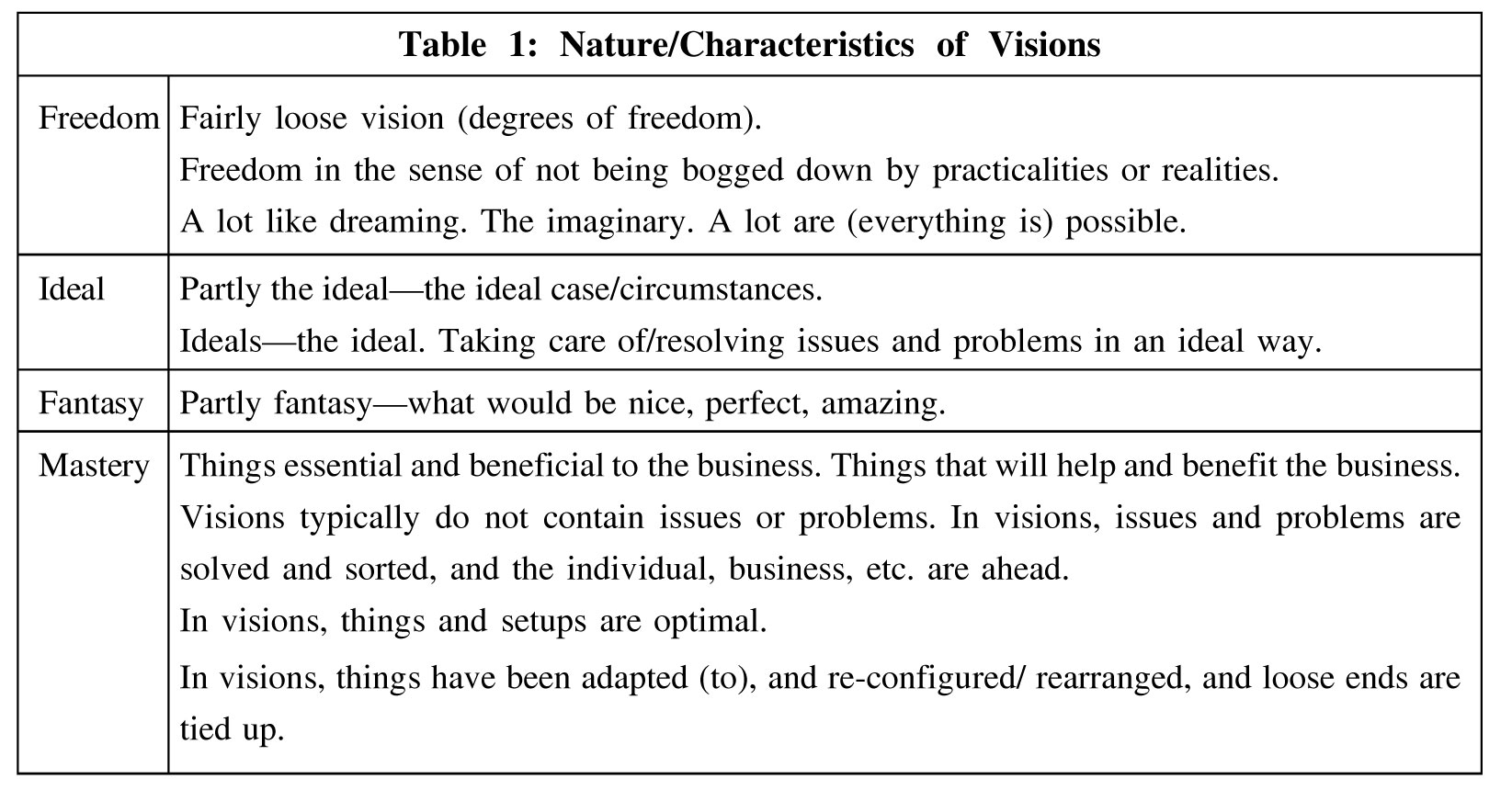
Relevance of Visions
Visions solve problems and contain solutions and answers to problems. They are practical and beneficial and involve what is logical and sensible, and from this perspective, make much sense. Visions are original and creative and thus permit innovation. Related to this, visions allow (taking) leaps, and stretch, through taking jumps. This then forward-catapults and enables a lot of progress and advancement. Visions make it possible to favorably and optimally (re)adapt to and (re)position within environments, contexts, circumstances, etc. Visions may entail (future) projections, and contribute to continuity, survival and prosperity. Visions capture aspirations (Wilson, 1992) (Table 2).
Significance of Visions
Visions provide and contain purpose, direction, foresight and strategy (Table 3). Vision is necessary for the purpose. Without vision, the focus may be overly on the short term, disregarding the long(er) term. Vision also reflects strategic extent?how strategic one is. Vision contains significant strategic components that may be difficult otherwise. Several things, like models, may be adequate or comprehensive, but not strategic (Lipton, 1996).
Implementing Visions
Successfully implementing visions requires visions to be practical. Visions can be implemented in phases and steps. Proper goals that also help to realize visions must be set. It must be resolved what is required to implement visions, and make the vision practical; also, what is standing in the way of the vision, and how this can be overcome. Visions require leadership: steering and guiding the vision, nurturing the vision, being proactive with regard to the vision, and taking the necessary decisions along the way. The strengths and weaknesses of the vision, threats to the vision, and needs of the vision must be delineated, be managed, also from a future perspective. Visions may involve many tactics?being tactical and shrewd about visions, implementing them, and moving them forward (Larwood et al., 1995).
Similarly, visions may simply require perseverance and tenacity to successfully implement: remain focus(ed) and committed, fighting to keep the vision alive, and pushing visions forward. External factors may influence visions, and this must receive attention, to ensure external factors do not harm or crash visions. Resources?people, setups and systems?can significantly contribute to and aid visions. Visions require alignment: operations, decisions, etc. must be aligned to the vision (Schoemaker, 1992) (Table 4).
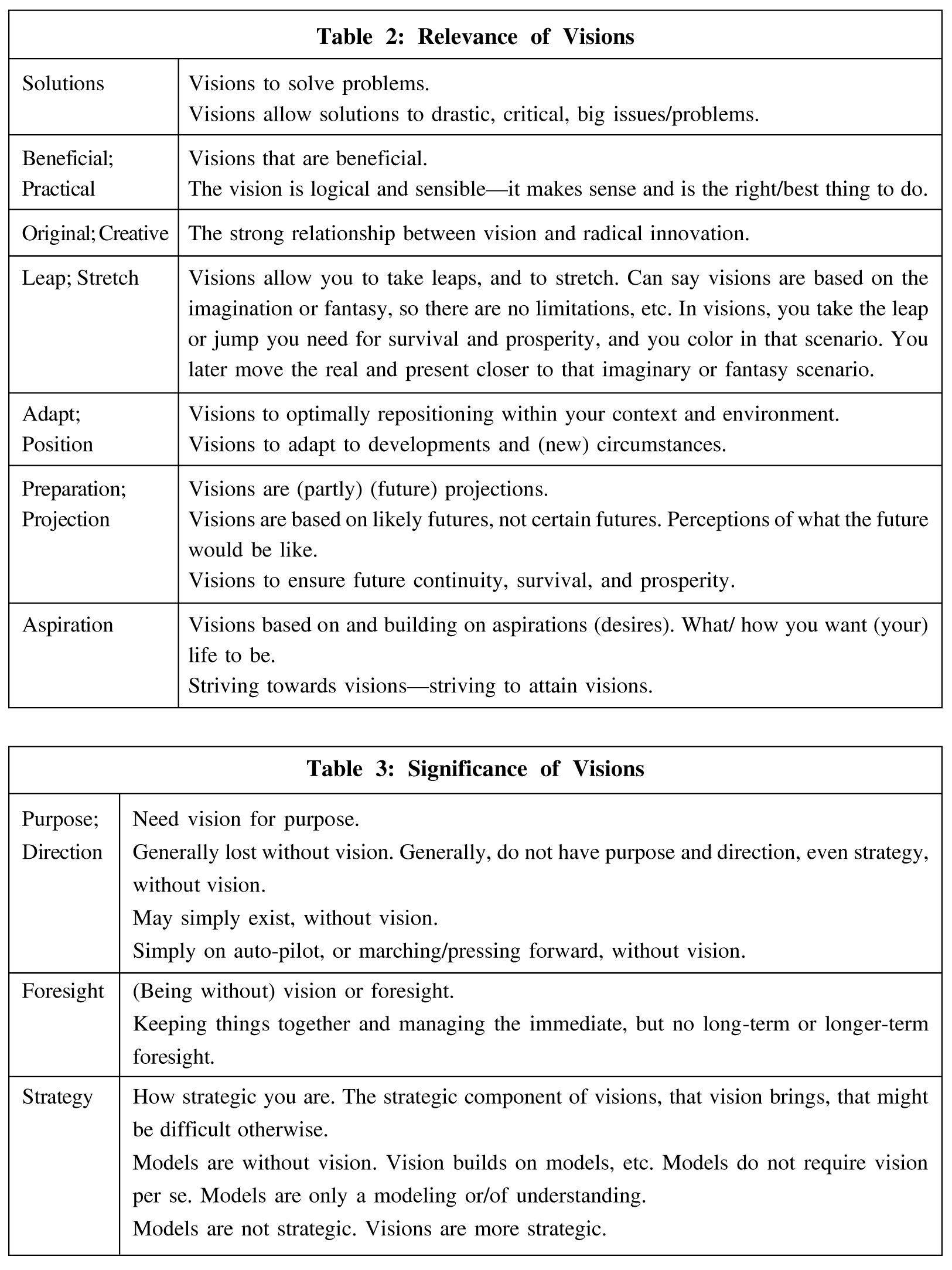
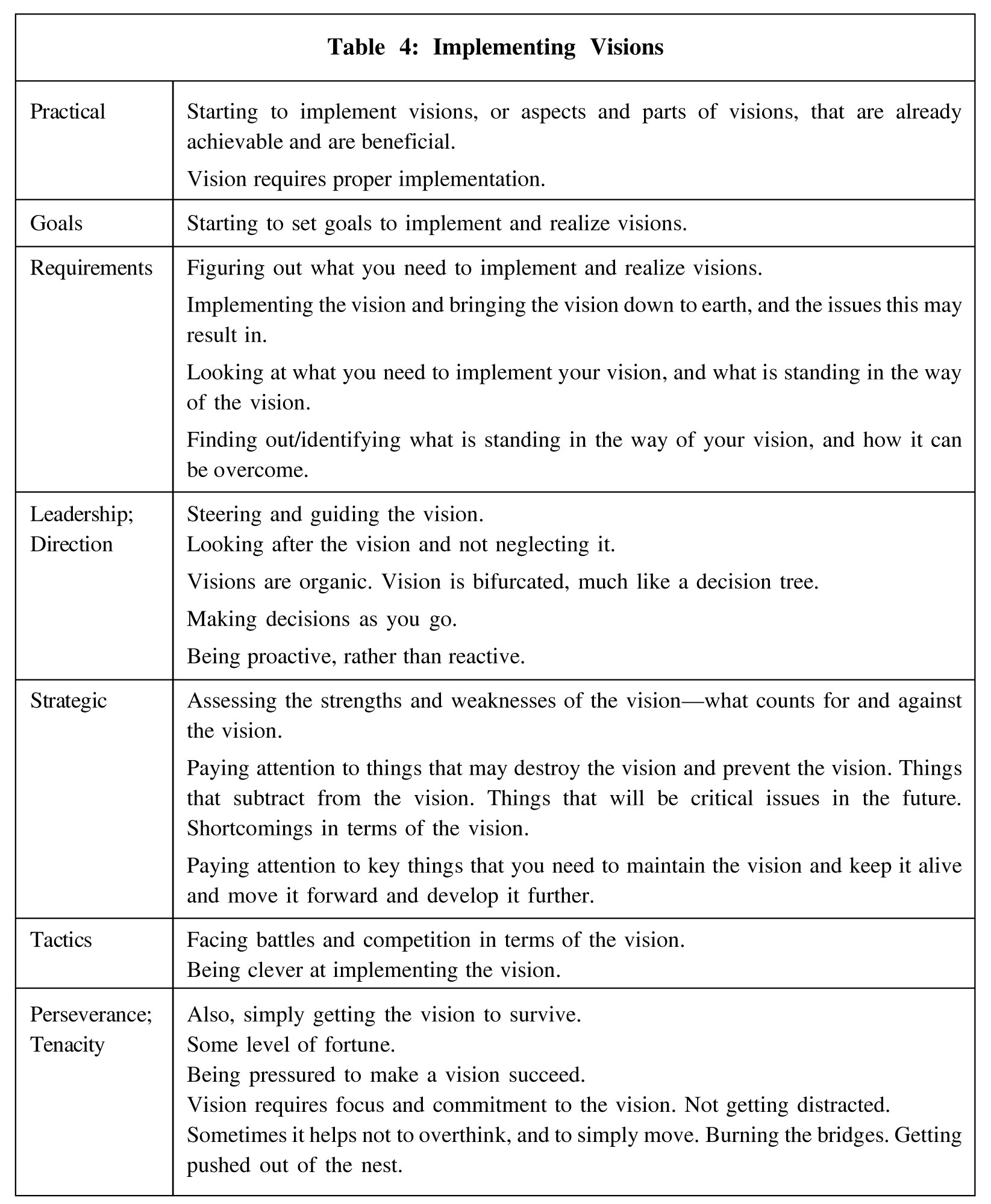
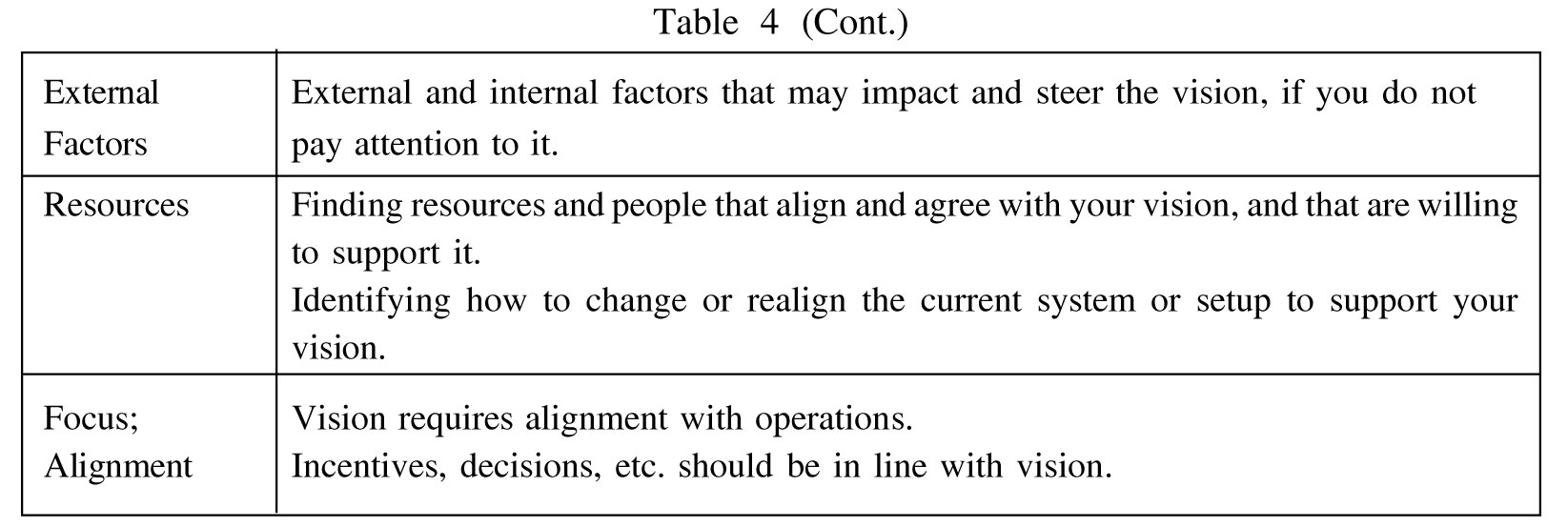
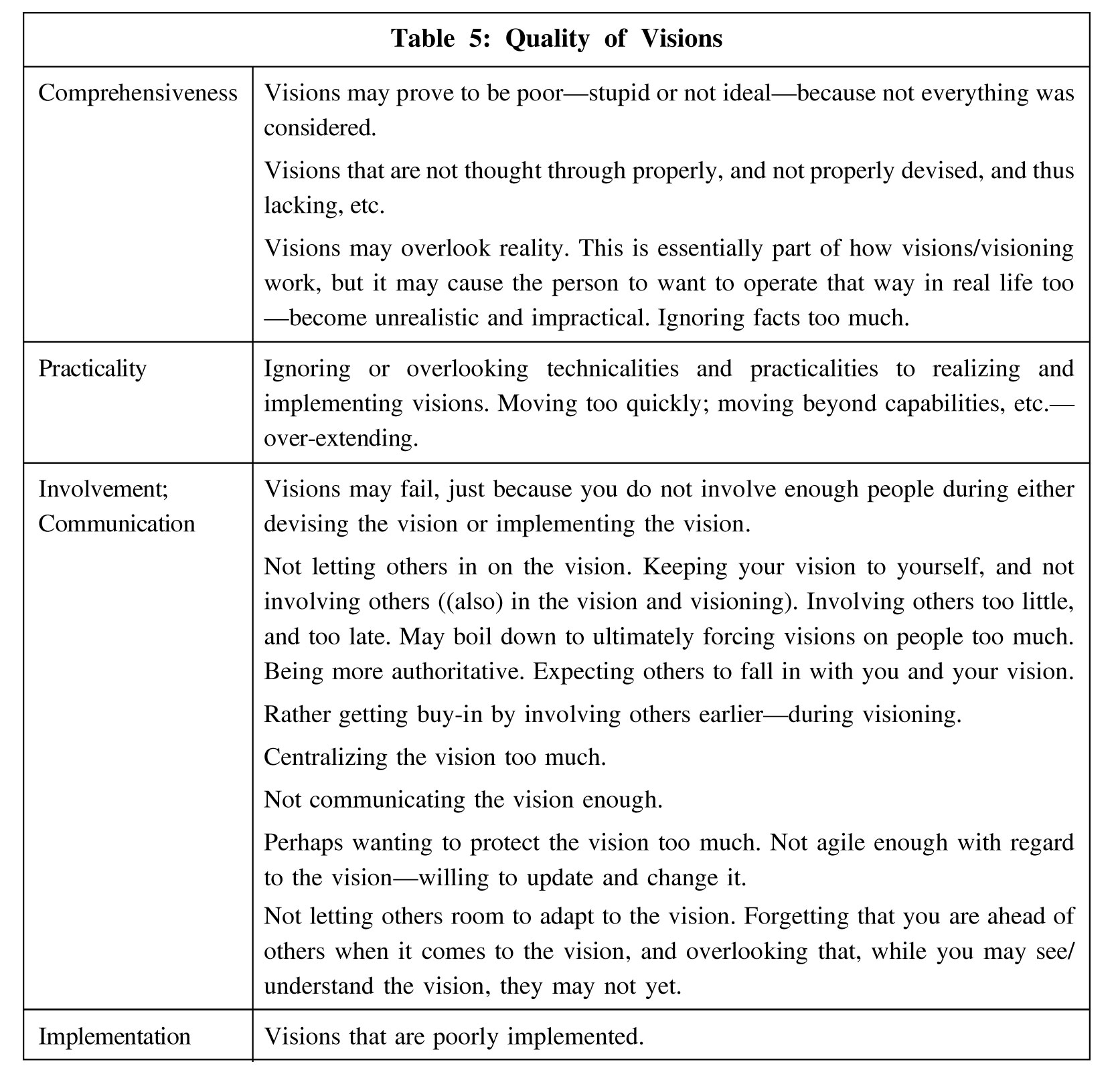
Quality of Visions
The quality of visions builds on (1) the comprehensiveness of the vision, (2) the practicality of the vision, (3) involvement and communication, and (4) proper implementation (see Table 5). Visions may not be thought through properly, may not be adequately devised, may not consider enough, and may overlook too much. Visions may not be practical enough and may overlook technicalities. Visions may not incorporate and involve significant stakeholders and others enough and may lack in terms of communication and articulation. This is both when devising and implementing visions. Visions may then lack in terms of buy-in and may inherently imply that the vision is forced onto others too much, and not giving them enough room to adopt and adapt to, the vision. To be successful, visions must be properly implemented (Dwivedi, 2006).
Factors Affecting Vision
Several factors affect vision. Intuition, knowledge, experience, and thinking all shape the construction?planning?of visions. Vision is very much based on the intuition. Knowledge, understanding, comprehension, depth of thought, quality of thought, perspective and experience collectively influence the comprehensiveness of visions. (Personal) Interests also shape the nature and content of visions, equally what is considered as (part of) visions. Leadership, time and timing are more internal factors that impact the management, etc., of visions. Visions involve and imply a strong leadership component: being proactive, taking charge, ownership, and responsibility, and wanting instead to shape things, than wait for them to change on their own. Visions require time commitments and investments. Visions equally entail developments, trajectories, continuities, and discontinuities, and therefore getting the timing right. Environments can impact visions and visioning. The environment may be conducive or restrictive to visioning, and to successfully implement a vision, may involve shaping and having to shape the environment. Developments can equally impact visions and must be managed and aligned with visions (Courtney et al., 1997).
Implementation of visions requires agility, frequent (re)evaluation and (re)assessment, and sound decision making. Surprises, inevitabilities, unexpectancies, and distractions must be dealt with quickly. Involving and incorporating others?the relevant stakeholders?improve solutions and increase buy-in and ownership. People are an essential resource and contribution when it comes to visions. It may be necessary to both partner and align with, and separate from, certain people, to see visions succeed. People can complement and advance visions. Visions are helped on by influence and charisma, as it helps to sell the vision (Schoemaker, 1992; and Khatri, 2005) (see Table 6).
Requirements/Building Blocks of Visions
Several factors and aspects contribute to visions: (1) intuition, (2) imagination, (3) curiosity, (4) creativity, (5) cognition and comprehension, (6) foresight, (7) strategic planning, (8) leadership, (9) experience, (10) goals, aspirations, and ambition, (11) innovation, (12) problems, and (13) values (Table 7).
Visions significantly involve the imagination and intuition. Visions also build on curiosity and interest, as it implies and advances understanding. Creativity is an integral part of visions. This includes creativity in the sense of breaking away and with and departing from the current and status quo. Visioning may imply a lot of creative play. Cognition and comprehension contribute to vision and visioning. It delineates comprehensiveness and depth of understanding. Visions require well-developed and holistic understanding. Perspective is vital for visioning and should be continuously developed (Collins and Porras, 2005).
Foresight is crucial for visions and expands visions. It depicts the direction things and developments are taking and entails accurate timing. Visions also have a dominant strategic component: being strategic, planning, positioning, and adapting. Visions also significantly build on leadership: giving direction. Experience and involvement advance learning, knowledge, understanding, expertise, sophistication, and efficiency, and facilitate and forward vision that way. One idea typically leads to the next. Goals, aspirations and ambitions lend to visions, by pushing known and current limits and boundaries, aiming higher, thinking bigger, taking on bigger challenges, and seeking solutions. Problems result in visions when problems are rather seen as opportunities. Innovation involves the new, and new ways, and this originality and novelty frequently enable vision as new thinking. Values constitute a predominant foundation and driver of visions. Values shape perspective and views, and in turn, vision (Malaska and Holstius, 1999; and Amarasingam, 2008).
Maturity
Visions have finite lifespans, do not last indefinitely, and equally, experience and go through life cycles. Visions develop, take off, mature, and subsequently decline. Timing is therefore essential?knowing when to both initiate and terminate a vision, when to move from one vision to the next, and when a new vision is called for. Visions exist in parallel with each other and common developments, and this affects their cycles and span
(Zohar, 2005).
In infancy, the premises and potential of a vision are still being explored, discovered and resolved. During growth, the vision takes off and experiences significant growth. In maturity, the vision can still be developed and grown, but growth is no longer that lucrative or rewarding. It becomes time to start to look for another vision and to start to transition to another vision. In decline, a new vision is (over)due, and the transition must be underway (Westley and Mintzberg, 1989; and Heger and Rohrbeck, 2012) (Table 8).
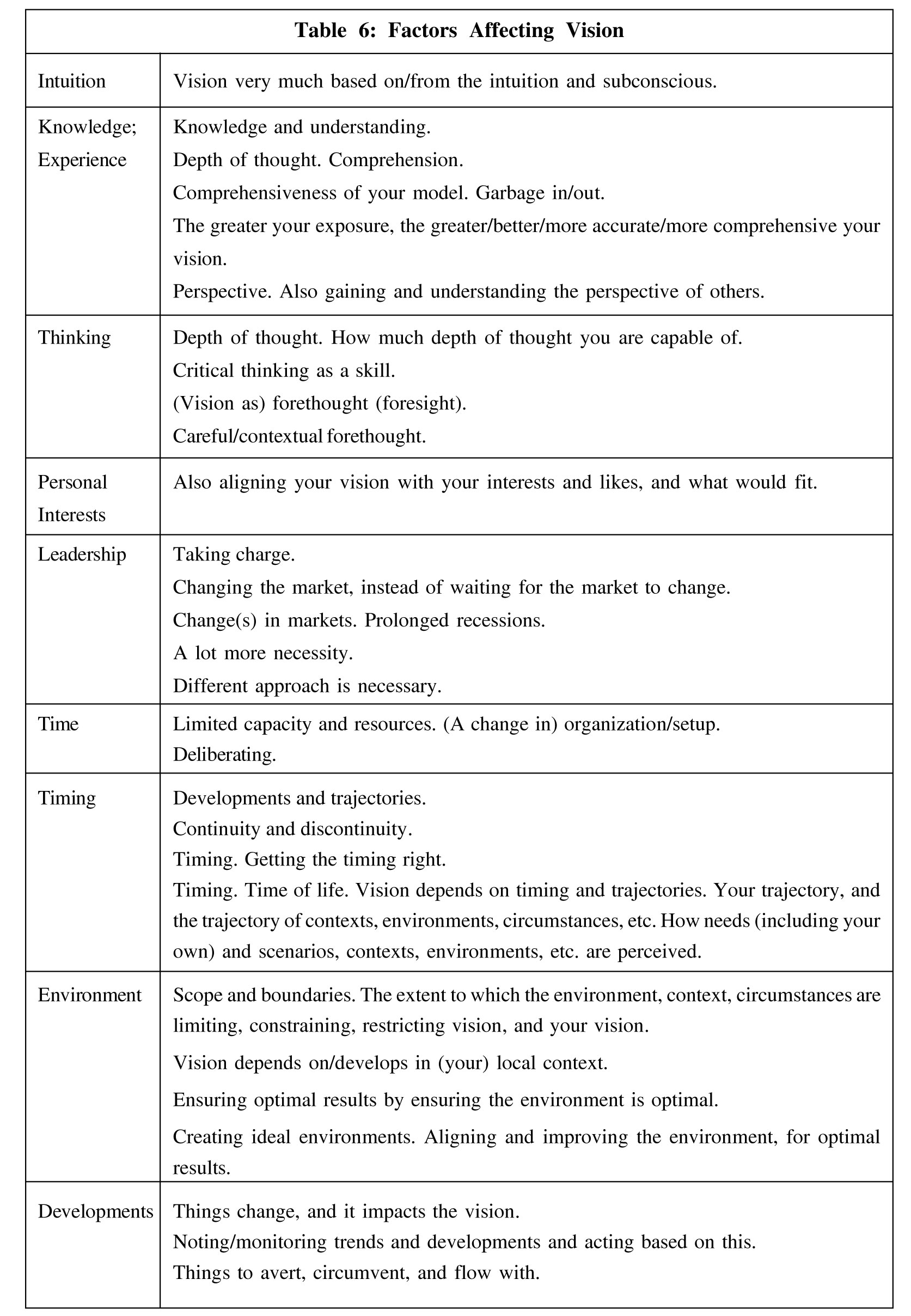
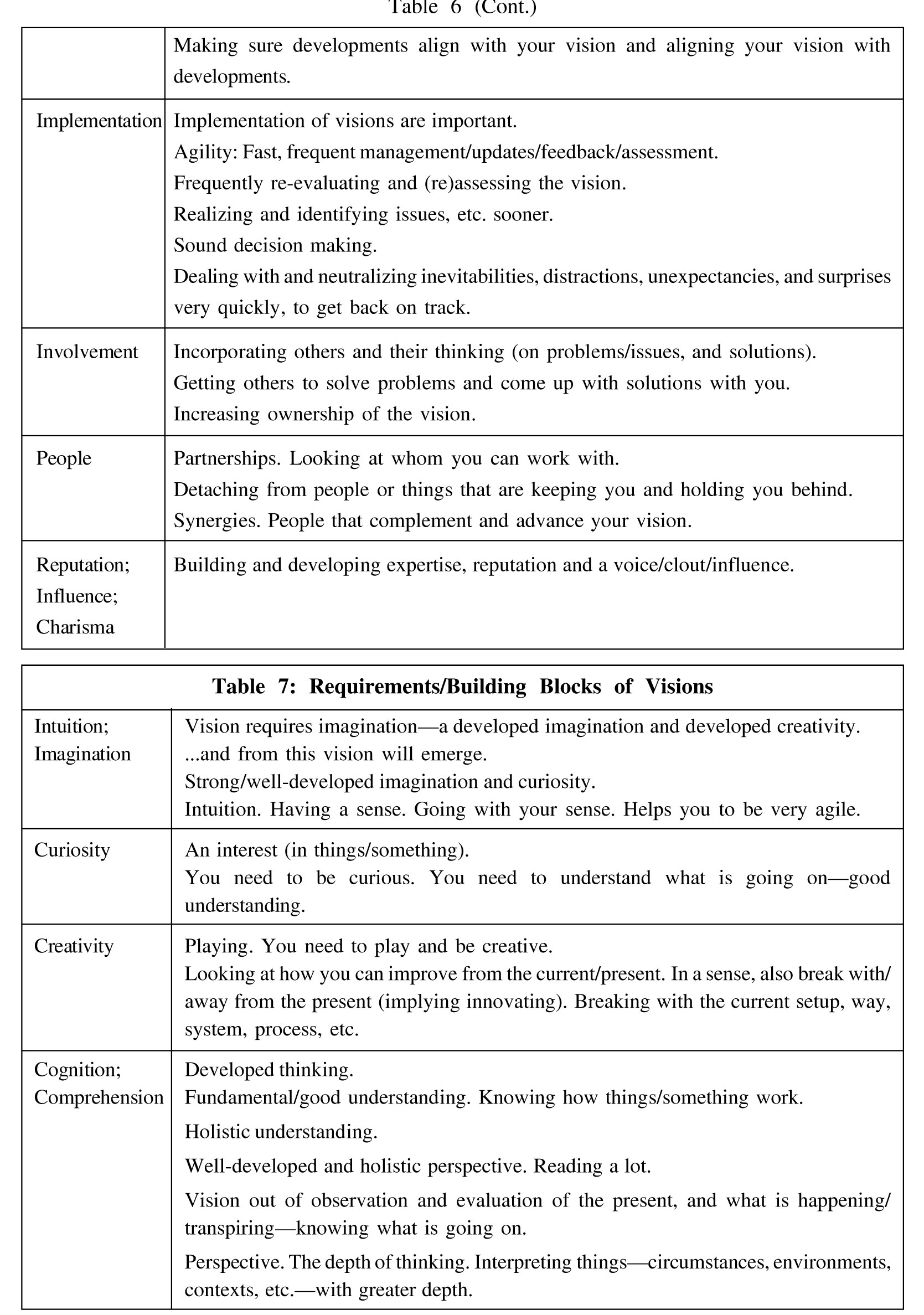
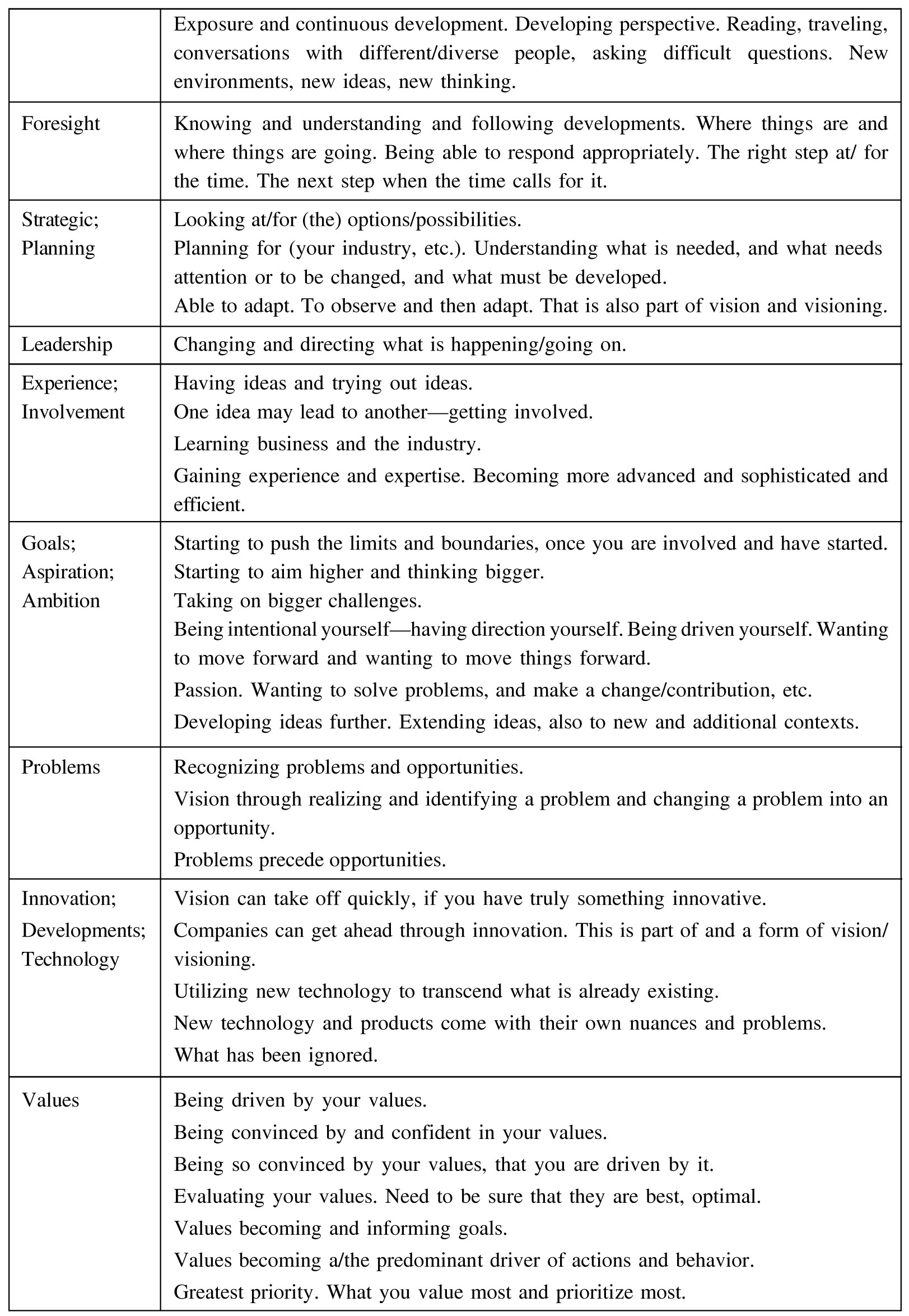
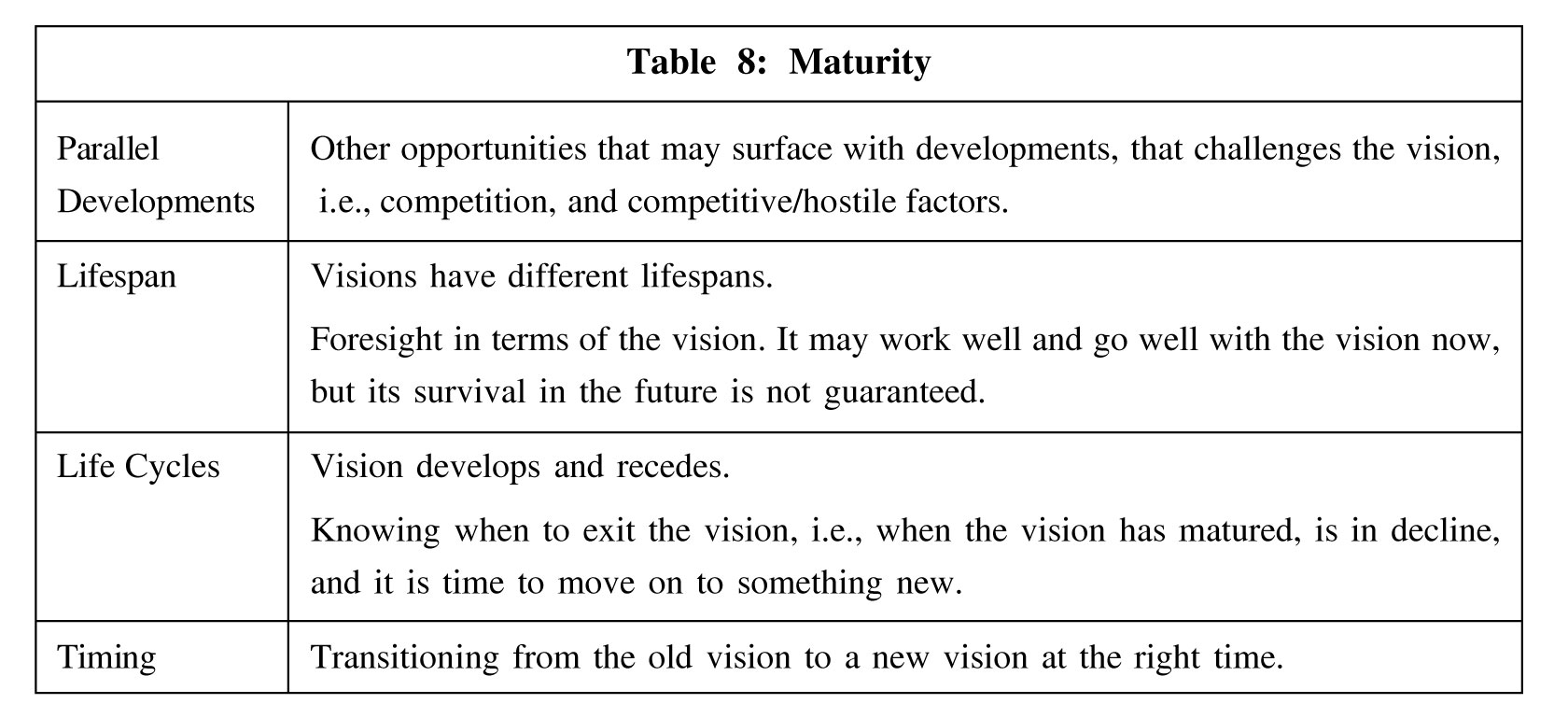
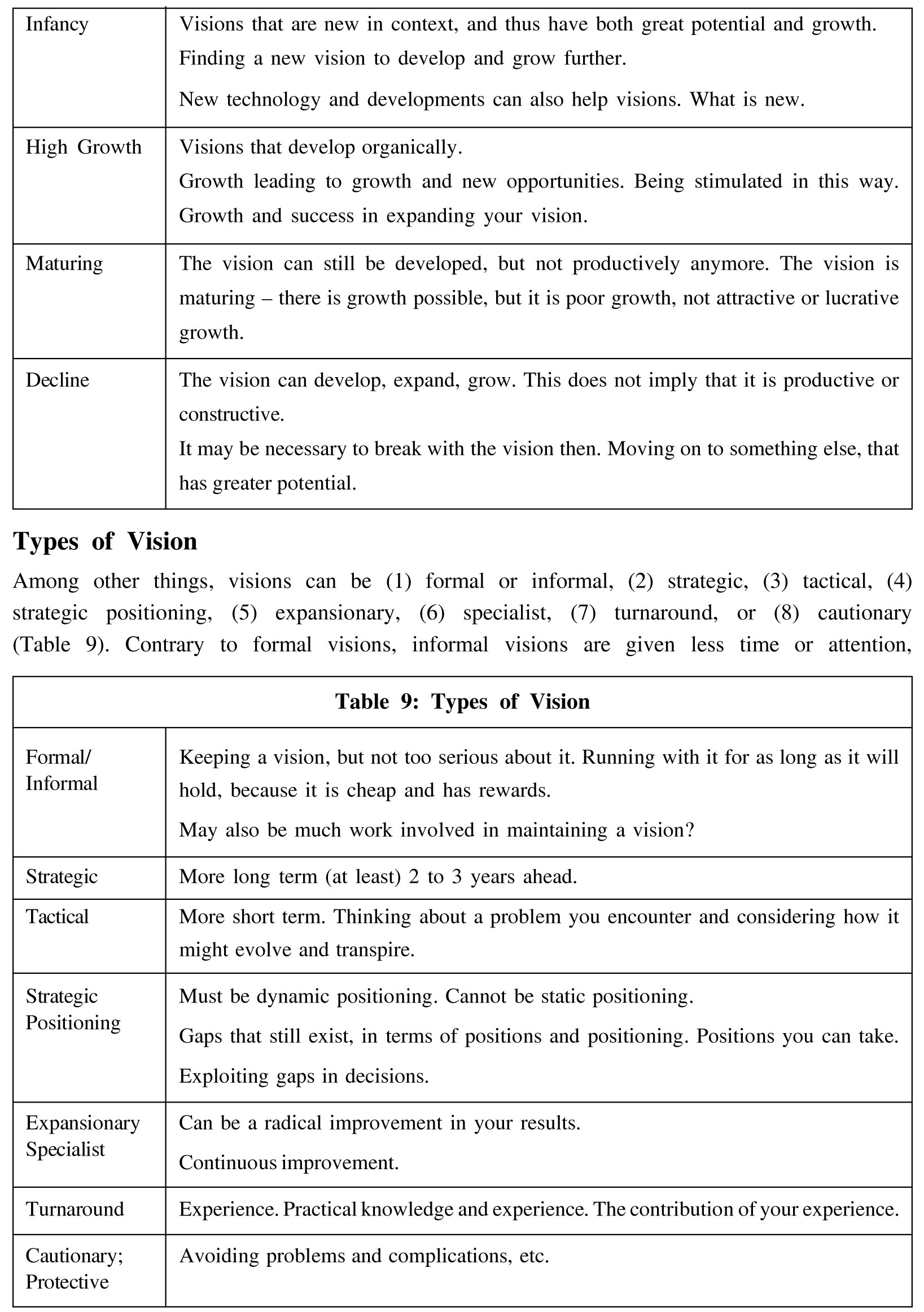
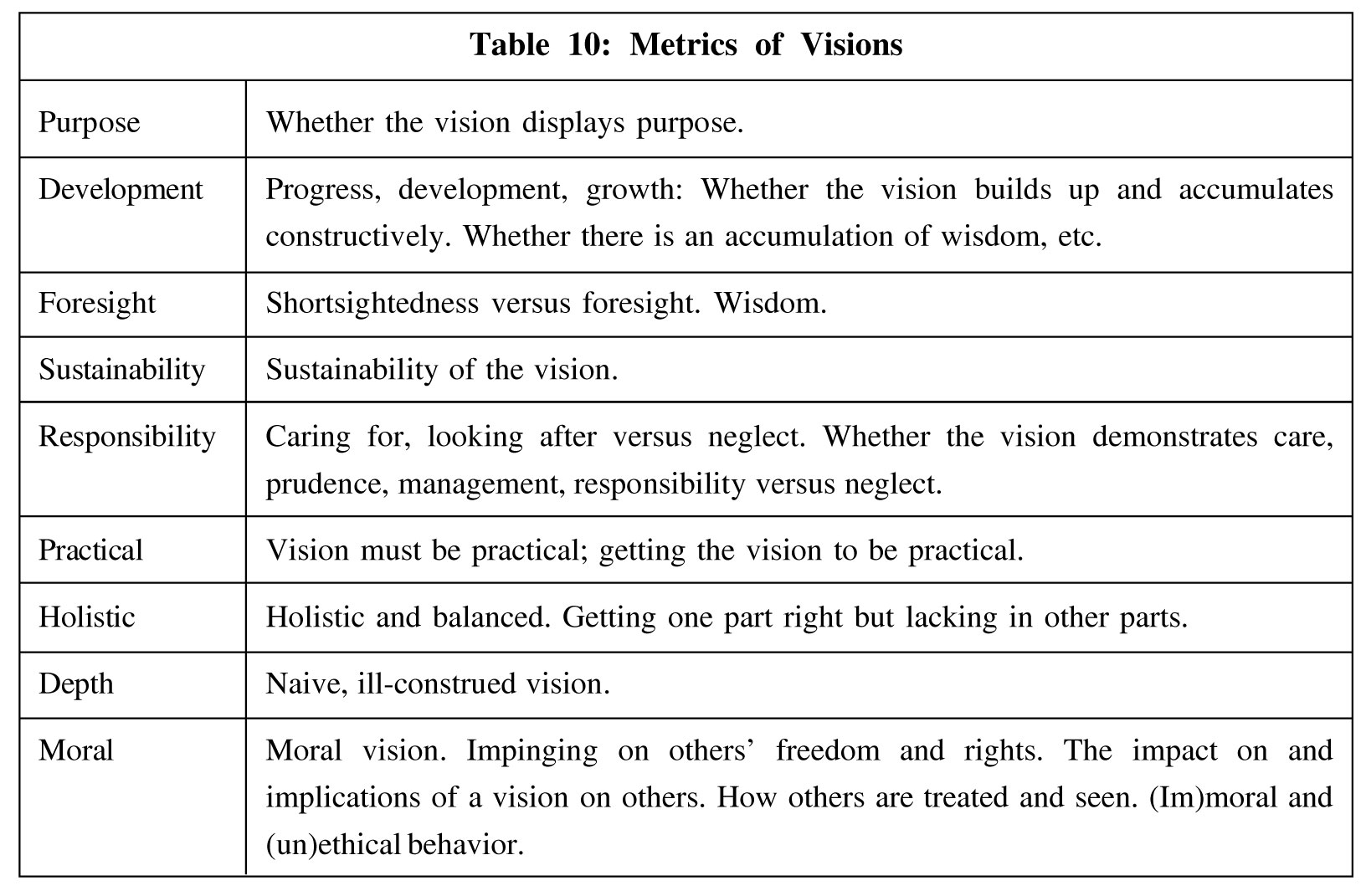
Types of Vision
Among other things, visions can be (1) formal or informal, (2) strategic, (3) tactical, (4) strategic positioning, (5) expansionary, (6) specialist, (7) turnaround, or (8) cautionary
(Table 9). Contrary to formal visions, informal visions are given less time or attention,particularly in terms of nurturing the vision and securing its continuity, and are thus less costly, easier to maintain, but also more arbitrary. Tactical visions focus on the short-term, whereas strategic visions emphasize the long-term. Strategic positioning visions seek to carve out and optimize relative positions dynamically. They identify and exploit existing gaps. Expansionary visions seek to extend positions, results, accomplishments, etc. Specialist visions concentrate on expertise-continuous improvement. Turnaround visions build on experience. Cautionary visions seek to avoid problems and complications.
Metrics of Visions
Visions can suffer from lack and be wrong. Visions are typically wrong to varying degrees. Attributes of good vision include: prudent/careful; accurate; (well) established; validated; worthwhile; purposeful; inclusive. Visions should contain purpose and must demonstrate development, progress, and improvement.
Furthermore, visions are evaluated based on their foresight or shortsightedness, and wisdom. Visions must reveal sustainability and responsibility: they should demonstrate care, regard, mindfulness and attentiveness, rather than neglect. Visions should be practical, to be implemented, and be implementable. Holistic and balanced visions get all parts right, not just some. The depth of thought and consideration of a vision are generally evident. Visions should have and require substantial moral and ethical premises (Slaughter, 1996) (Table 10).
Lack in Vision
Typical deficiencies in terms of visions include group-think, morals, sustainability, responsibility, foresight, and dependency. Vision demonstrates group-think-being led by popular views and outlooks. Visions lack in terms of morals and morality, and poorly consider consequences. Visions are not always sustainable or responsible and may be overly focused on short-term gains, getting ahead, and being self-serving. Visions typically ignore warning signals. Moreover, visions lack independence and contingency planning (Tellis, 2006)
(Table 11).
Personal Development
Visions have a robust personal development component. Things like experience and foundation (character) make the vision and visioning difficult, and not merely a straightforward (cut and paste) process. The person should be open-minded in terms of thinking and be willing to expand boundaries in terms of thinking. He must be willing to examine and question paradigms he subscribes to. The individual should develop his creativity and build his experience and expertise. He requires a strong moral and ethical foundation, to be capable of moral, ethical, and constructive thought. Strong character is crucial, yet does not develop overnight, and cannot be developed artificially. Visions require accountability and oversight, and the person must be willing to be accountable (to someone). The individual must be a dreamer, yet extremely realistic. The person must be persistent, determined, and willing to run with his ideas and give things a try (Holstius and Malaska, 2014) (Table 12).
Conclusion
Visions involve dreaming and the imagination and build on the ideal and fantasy. They allow a lot of freedom. They are therefore very creative and constructive. Visions surface solutions and help solve problems. They are original, practical and relevant. Visions also permit leaps-progress. Visions make it possible to (re)adapt and (re)position within environments, contexts, circumstances, etc. Visions capture forecasts and aspirations. Visions provide and contain purpose, direction, foresight and strategy.
To successfully implement, visions must be made practical. Goals should be set. The requirements of the vision must be resolved. Visions are guided and require leadership. The weaknesses of and threats to the vision are noted. Visions require tactics, perseverance and tenacity. Visions must be protected from external forces. Visions require alignment. Visions are aided by sourcing the appropriate resources.
Several factors affect the quality of visions (comprehensiveness, practicality, involvement, implementation). Overall, several factors affect visions (intuition; knowledge; experience; thinking; interests; leadership; timing; resources; environment).
Implementation of visions requires agility, frequent (re)evaluation and (re)assessment, and sound decision making. Involving and incorporating others-the relevant stakeholders-improve solutions and increase buy-in and ownership.
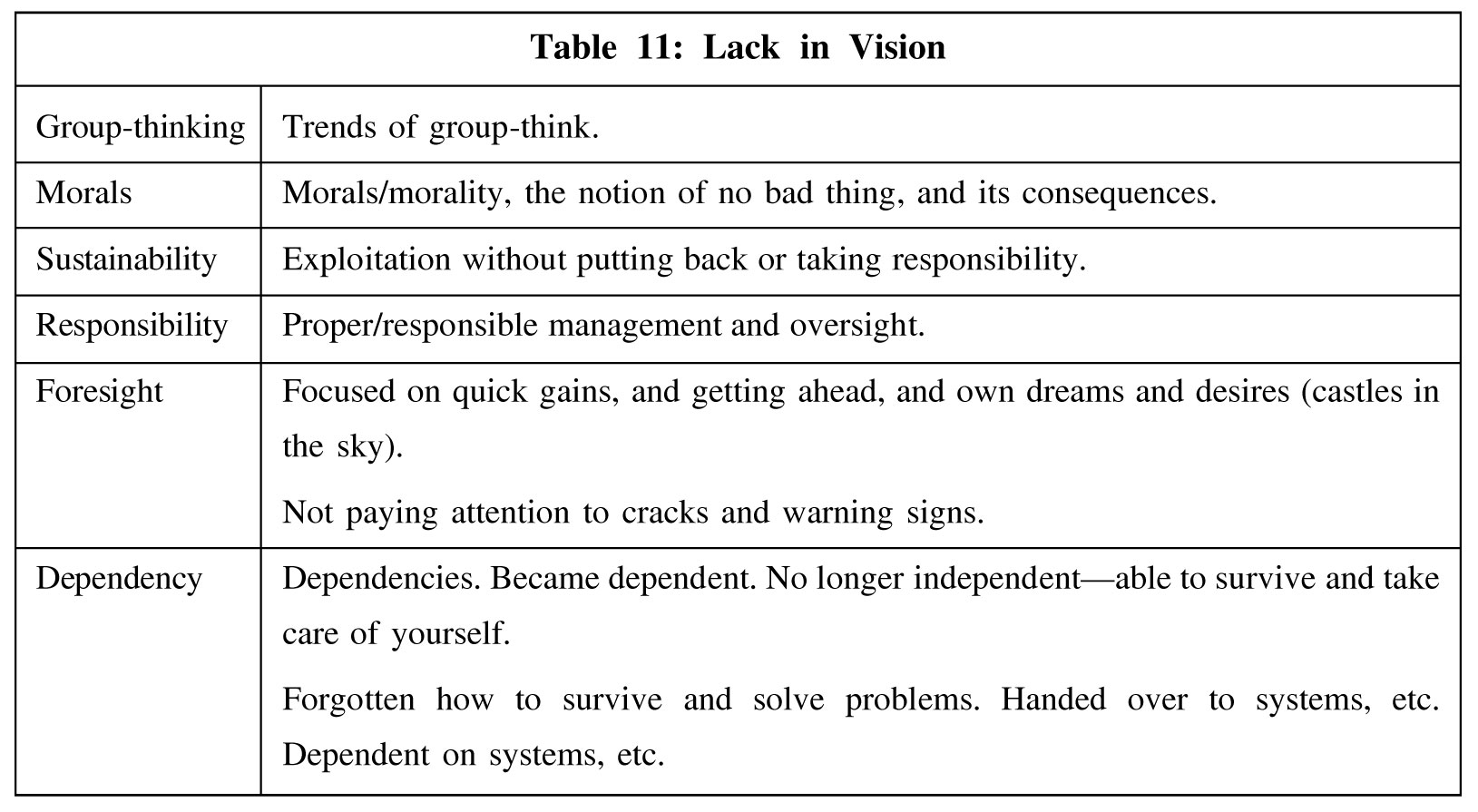

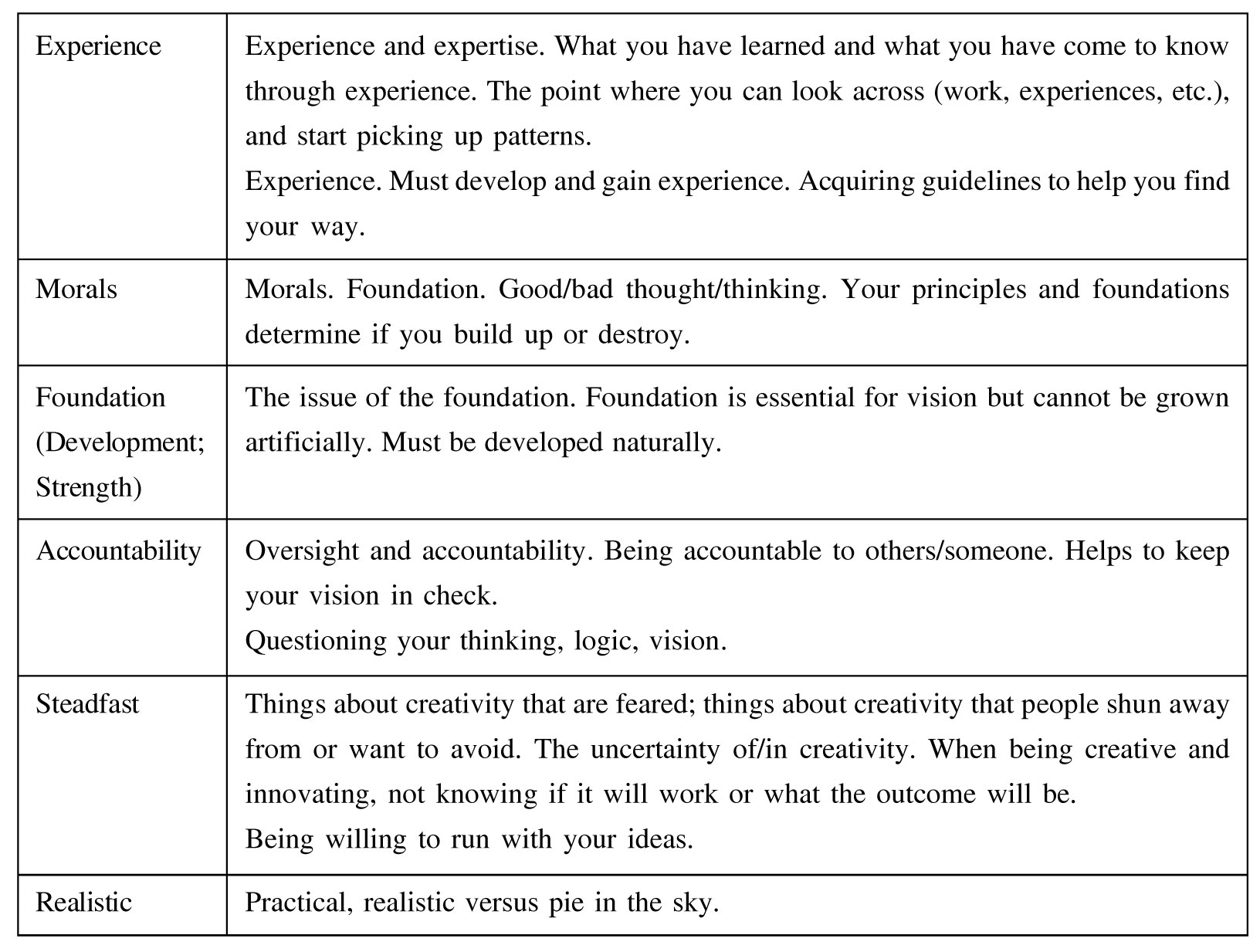
Several factors and aspects contribute to visions: (1) intuition, (2) imagination, (3) curiosity, (4) creativity, (5) cognition and comprehension, (6) foresight, (7) strategic planning, (8) leadership, (9) experience, (10) goals, aspirations, and ambition, (11) innovation, (12) problems, and (13) values.
Visions have finite lifespans, do not last indefinitely, and equally, experience and go through life cycles. It is important to know when to move from one vision to the next.
Among other things, visions can be (1) formal or informal, (2) strategic, (3) tactical, (4) strategic positioning, (5) expansionary, (6) specialist, (7) turnaround, or (8) cautionary.
Visions can lack and be wrong. Visions are evaluated against several aspects (purpose; development; foresight; sustainability; responsibility; practical; holistic; depth; morals).
Typical deficiencies in terms of visions include group-think, morals, sustainability, responsibility, foresight, and dependency.
Visions have a strong personal development component. Things like experience and foundation (character) make the vision and visioning difficult, and not merely a straightforward process.
Limitations: The limitations of this study are listed below:
- A representative sample is difficult to obtain as only a few entrepreneurs were interviewed. For practical reasons, the entrepreneurs will be based in South Africa and will relate to the South African context. This impacts on external validity which is discussed in the following section. However, external validity is less of a concern, as the study is more interested in gaining insight, than generalizing to the general population.
- The findings cannot be generalized for the rest of the population but will give insights to individuals' perspectives.
- The researcher's personal views and beliefs are inherently part of the research which leaves room for different interpretations of the data.
Future Research: Future research can further investigate the following:
- The contribution of visions: Noting the extent to which vision can be linked to the success of entrepreneurs.
- The implementation of visions: The ability of entrepreneurs to implement-bring to earth-their visions, and what they typically get wrong in this regard.
- Quality of visions: Aspects/factors of the quality of visions were devised. This can be further developed. Also, the quality of visions entrepreneurs can devise, can be investigated.
- The comprehensiveness of visions: What entrepreneurs typically get wrong, and lack, in terms of visions.
- Types of visions: The types of visions entrepreneurs are prone to use (in a market), and the unique ways in which entrepreneurs use visions, can be examined further.
- Personal development and visions: How personal development impacts visioning.
- External factors and visioning: The external impact factors, particularly environment, has on visions and visioning.
References
- Amarasingam A (2008), "Transcending Technology: Looking at Futurology as a New Religious Movement", Journal of Contemporary Religion, Vol. 23, No. 1, pp. 1-16.
- Aviles J A G and Carvajal M (2008), "Integrated and Cross-Media Newsroom Convergence: Two Models of Multimedia News Production-The Cases of Novotecnica and La Verdad Multimedia in Spain", Convergence, Vol. 14, No. 2, pp. 221-239.
- Babbie E R (2014), The Basics of Social Research.
- Bell J (2005), "Doing Your Research Project: A Guide for First-Time Researchers" in Social Science, Education and Health, McGraw-Hill International, New-York.
- Blaxter L (2010), How to Research, McGraw-Hill Education, UK.
- Christensen C (2013), The Innovator's Dilemma: When New Technologies Cause Great Firms to Fail, Harvard Business Review Press.
- Collins J C and Porras J I (2005), Built to Last: Successful Habits of Visionary Companies, Random House.
- Courtney H, Kirkland J and Viguerie P (1997), "Strategy Under Uncertainty", Harvard Business Review, Vol. 75, No. 6, pp. 67-79.
- Creswell J W (2014), A Concise Introduction to Mixed Methods Research, Sage Publications.
- . Crowther D and Lancaster G (2009), Research Methods: A Concise Introduction to Research in Management and Business Consultancy, Butterworth-Heinemann.
- Darlington Y, Scott D and Scott D (2002), Qualitative Research in Practice: Stories from the Field, Open University Press, Buckingham.
- Dwivedi R (2006), "Visionary Leadership: A Survey of Literature and Case Study of Dr APJ Abdul Kalam at DRDL", Vision, Vol. 10, No. 3, pp. 11-21.
- Elenkov D S, Judge W and Wright P (2005), "Strategic Leadership and Executive Innovation Influence: An International Multicluster Comparative Study", Strategic Management Journal, Vol. 26, No. 7, pp. 665-682.
- Given L M (2008), The Sage Encyclopedia of Qualitative Research Methods, Sage Publications.
- Gooday G (1998), "Taking Apart the ‘Roads Ahead' User Power Versus the Futurology of IT", Convergence, Vol. 4, No. 3, pp. 8-16.
- Heger T and Rohrbeck R (2012), "Strategic Foresight for Collaborative Exploration of New Business Fields", Technological Forecasting and Social Change, Vol. 79, No. 5, pp. 819-831.
- Holstius K and Malaska P (2014), Advanced Strategic Thinking: Visionary Management.
- Ireland R D and Hitt M A (1999), "Achieving and Maintaining Strategic Competitiveness in the 21st Century: The Role of Strategic Leadership", Academy of Management Perspectives, Vol. 13, No. 1, pp. 43-57.
- Jing F F and Avery G C (2008), "Missing Links in Understanding the Relationship Between Leadership and Organizational Performance", International Business and Economics Research Journal, Vol. 7, No. 5, p. 67.
- Johnson G, Whittington R, Scholes K, Angwin D and Regner P (2017), Exploring Strategy: Text and Cases, 11th Edition, Pearson Education Limited, UK.
- Kalof L, Dan A and Dietz T (2008), Essentials of Social Research, McGraw-Hill Education, UK.
- Kantabutra S (2010), "What Do We Know About Vision", Leading Organizations: Perspectives for a New Era.
- Ketchen D J, Ketchen Jr D J and Bergh D D (2006), Research Methodology in Strategy and Management, Emerald Group Publishing.
- Khatri N (2005), "An Alternative Model of Transformational Leadership", Vision, Vol. 9, No. 2, pp. 19-26.
- Kim W C and Mauborgne R (2004), "Value Innovation: The Strategic Logic of High Growth", Harvard Business Review, Vol. 82, Nos. 7&8, pp. 172-180.
- Larwood L, Falbe C M, Kriger M P and Miesing P (1995), "Structure and Meaning of Organizational Vision", Academy of Management Journal, Vol. 38, No. 3, pp. 740-769.
- Levin I M (2000), "Vision Revisited: Telling the Story of the Future", The Journal of Applied Behavioral Science, Vol. 36, No. 1, pp. 91-107.
- Lipton M (1996), "Demystifying the Development of an Organizational Vision", Sloan Management Review, July.
- Malaska P and Holstius K (1999), "Visionary Management", Foresight, Vol. 1, No. 4, pp. 353-361.
- Mico J, Masip P and Barbosa S (2009), "Models of Business Convergence in the Information Industry: A Mapping of Cases in Brazil and Spain", Brazilian Journalism Research, Vol. 5, No. 1, pp. 123-140.
- Mumford T V, Campion M A and Morgeson F P (2007), "The Leadership Skills Strataplex: Leadership Skill Requirements Across Organizational Levels", The Leadership Quarterly, Vol. 18, No. 2, pp. 154-166.
- Nonaka I and Peltokorpi V (2006), "Visionary Knowledge Management: The Case of Eisai Transformation" International Journal of Learning and Intellectual Capital, Vol. 3, No. 2, pp. 109-209.
- Ritchie J, Spencer L and O'Connor W (2003), "Carrying Out Qualitative Analysis", in Jane Ritchie and Jane Lewis (Eds.), Qualitative Research Practice: A Guide for Social Science Students and Researchers, pp. 219-262, SAGE Publications.
- Robinson J B (1990), "Futures Under Glass: A Recipe for People Who Hate to Predict", Futures, Vol. 22, No. 8, pp. 820-842.
- Schoemaker P J (1992), "How to Link Strategic Vision to Core Capabilities", Sloan Management Review, Vol. 34, pp. 67-67.
- Shipley R (2002), "Visioning in Planning: Is the Practice Based on Sound Theory?", Environment and Planning A, Vol. 34, No. 1, pp. 7-22.
- Slaughter R A (1996), "Futures Studies: From Individual to Social Capacity", Futures-the Journal of Forecasting Planning and Policy, Vol. 28, No. 8, pp. 751-762.
- Slaughter R A (1997), "Developing and Applying Strategic Foresight", ABN Report, Vol. 5, No. 10, pp. 13-27.
- Tellis G J (2006), "Disruptive Technology or Visionary Leadership?", Journal of Product Innovation Management, Vol. 23, No. 1, pp. 34-38.
- Tiwari R, Buse S and Herstatt C (2006), "From Electronic to Mobile Commerce: Opportunities Through Technology Convergence for Business Services".
- Vecchiato R and Roveda C (2010), "Strategic Foresight in Corporate Organizations: Handling the Effect and Response Uncertainty of Technology and Social Drivers of Change", Technological Forecasting and Social Change, Vol. 77, No. 9, pp. 1527-1539.
- Walliman N (2017), Research Methods: The Basics, Routledge.
- Westley F and Mintzberg H (1989), "Visionary Leadership and Strategic Management", Strategic Management Journal, Vol. 10, No. S1, pp. 17-32.
- Willig C (2008), Introducing Qualitative Research in Psychology, Open University Press, McGraw-Hill, Maidenhead.
- Wilson I (1992), "Realizing the Power of Strategic Vision", Long Range Planning, Vol. 25, No. 5, pp. 18-28.
- Wirtz B W (1999), "Convergence Processes, Value Constellations and Integration Strategies in the Multimedia Business", International Journal on Media Management, Vol. 1, No. 1, pp. 14-22.
- Zohar D (2005), "Spiritually Intelligent Leadership", Leader to Leader, Vol. 38, pp. 45-51.
